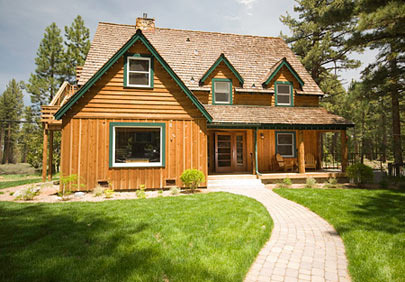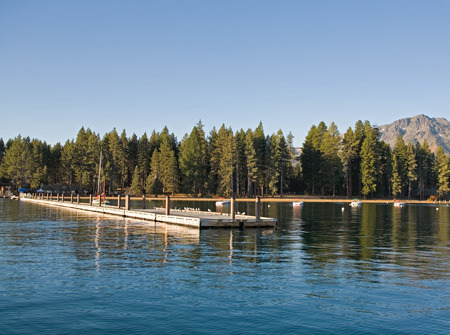Mark Sisson's Blog, page 357
November 21, 2012
PrimalCon Lake Tahoe 2013 Registration Now Open!
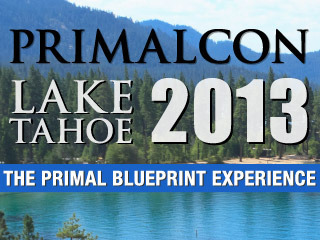 Back in July, when I announced PrimalCon IV (April 11-14, 2013 in Oxnard, CA), my team and I were absolutely floored to watch the event completely sell out in only nine days. Clearly, PrimalCon has grown from its modest beginnings (33 brave souls came to Oxnard in 2010) to become a centerpiece of the Mark’s Daily Apple community and the Primal lifestyle. Meanwhile, it’s been breaking my heart to repeatedly turn down interested folks who inquire about next April’s Oxnard event. After all, we publish testimonials describing the retreat as “life changing”, and the food as the “best you will ever eat.”
Back in July, when I announced PrimalCon IV (April 11-14, 2013 in Oxnard, CA), my team and I were absolutely floored to watch the event completely sell out in only nine days. Clearly, PrimalCon has grown from its modest beginnings (33 brave souls came to Oxnard in 2010) to become a centerpiece of the Mark’s Daily Apple community and the Primal lifestyle. Meanwhile, it’s been breaking my heart to repeatedly turn down interested folks who inquire about next April’s Oxnard event. After all, we publish testimonials describing the retreat as “life changing”, and the food as the “best you will ever eat.”
Clearly, something had to be done. And today, I’m pleased to announce PrimalCon Lake Tahoe, slated for September 26th-29th, 2013! Yes, we shall venture beyond the shores of Southern California to experience one of the most beautiful natural environments on earth, during the best time of the year there. We have taken over the Camp Richardson Historic Resort, situated right on the Southern shore of the lake, between South Lake Tahoe, CA and Emerald Bay. We have reserved various dwellings on the property, including the historic Camp Richardson Hotel and Camp Richardson House, Beachside Motel, and deluxe cabins that sleep between 2 and 8 people. All the lodging options are described and shown (pics and video) at the Camp Richardson website. You’ll book directly with the resort – instructions to follow.
While the PrimalCon Oxnard agenda template and returning presenters have been well-received, we want to offer a slightly different experience in Lake Tahoe. We’ll feature some new presenters itching to share their magic, and devote ample time to engage with nature on mountain hikes and water activities on the lake.
Agenda
Here’s a quick glance of what the PrimalCon Tahoe agenda will look like.
Thursday
Evening dinner and mixer at Camp Richardson boathouse
Friday
Morning: Hike (easy and hard options) to Angora Lakes for swim and cliff jumping, return for lunch
Afternoon: Presenter free choice time at Camp Richardson
Evening: Primal feast, followed by wine and chocolate campfire at Camp Richardson
Saturday
Morning: Primal Blueprint Fitness activities at athletic field, return for lunch
Afternoon: Water sports at Lake Tahoe (kayak, standup paddle)
Keynote address from Mark Sisson and Robb Wolf
Evening: Early Primal feast, sunset luxury yacht cruise to world-famous Emerald Bay, wine and chocolate campfire
Sunday
Morning: Presenter free choice time at Camp Richardson, followed by lunch and closing address
Travel
Lake Tahoe is convenient to Reno International Airport (64 miles), Sacramento International Airport (115 miles), and San Francisco International Airport (200 miles). South Lake Tahoe Express has numerous daily departures from Reno airport to South Lake Tahoe casinos and back. Round trip tickets are $49. We will have van and auto service available to transport you to Camp Richardson from your casino shuttle stop throughout Thursday afternoon, and to go from Camp to casino shuttle for Sunday afternoon return trips. Casinos are seven miles from Camp Richardson.
Lodging: Camp Richardson
Click images to enlarge
We aspire to create a great sense of community by taking over Camp Richardson and encouraging you to stay there at outstanding off-season rates. There are numerous lodging options at Camp Richardson, and are likely to go quickly after this PrimalCon announcement. You can peruse the Camp Richardson website to view detailed photo and video descriptions of the various lodging options, which include the Camp Richardson hotel, Beachside motel, Richardson historic house and assorted deluxe cabins sleeping from 2 to 8 people. You will make reservations directly with the resort by calling 800-544-1801. Get a group together or jump on the PrimalCon Forum and see if you can assemble a Primal clan to rent one of the beautiful cabins! Also, South Lake Tahoe has abundant small motels (2 miles away) and large casino hotels (8 miles away) to choose from at various budget levels. If you want to go full Primal and tent camp, we have a few spots reserved at Camp Richardson, email with interest.
Weather
Lake Tahoe is at 6,224’ above sea level so you will experience their wonderful fall Sierra Nevada weather of sunny, temperate days and cold nights. Watch the forecast before your departure and pack well in case of extremes. Average high on Sept 26th is 70 ºF, average low is 32 ºF. Sunrise 6:52 am, sunset 6:50 pm.
More About PrimalCon
In case you haven’t heard (or reviewed the links from 2010, 2011, and 2012), PrimalCon is our three-day health and fitness retreat – a total immersion weekend experience of expert-guided workouts, play, leisure time, lectures and presentations with assorted expert presenters on Primal-related topics, camaraderie with fellow Primal enthusiasts, and extraordinary Primal feasts – an experience that you will never forget for the rest of your life. PrimalCon is more than just great food and a lively and diverse agenda blending lectures. The truly magical element is the gathering of like-minded folks from all over the globe who share a tremendous passion for living Primally.
PrimalCon welcomes participants of all fitness and experience levels. Really, we make it work for everyone! If you’re a hardcore CrossFit Games type, we’ll have stuff to test your mettle, including our legendary PrimalCon Ultimate Frisbee battles (winners hit the dinner buffet line first—high stakes indeed!). If you are new to Primal living, relatively unfit, injured, whatever, don’t worry – you will fit right in. Our staff makes a sincere effort to ensure that you receive appropriate guidance and pace yourself well all weekend. We also offer extensive pick-and-choose flexibility on the daily agendas, so you can custom design your ideal experience. Yep, you can engage with your favorite presenter repeatedly, or escape to the lake for a spell – we won’t tell!
The conference fee is $849, which includes morning Primal Fuel coconut milk smoothies and snack spreads, delicious catered Primal lunch and dinner buffets, and a lavish goodie bag of apparel and other Primal gear. Upon receipt of your registration, we encourage you to call Camp Richardson (800-544-1801) and immediately book your accommodations. To ensure an intimate experience and direct engagement with me and the other presenters, slots are limited to the first 100 registrants.
What to Expect from PrimalCon Lake Tahoe 2013
Seminars and presentations include general sessions with me and other featured presenters with specialized areas of expertise directly related to the Primal movement.
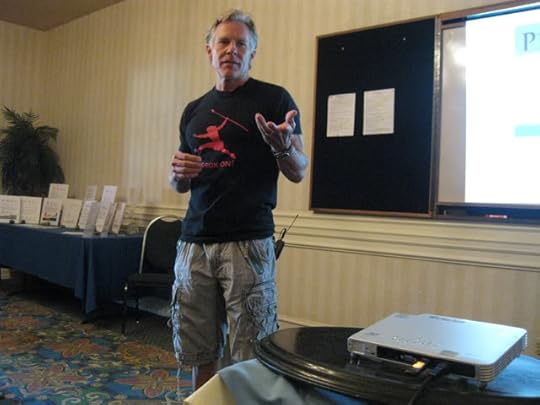
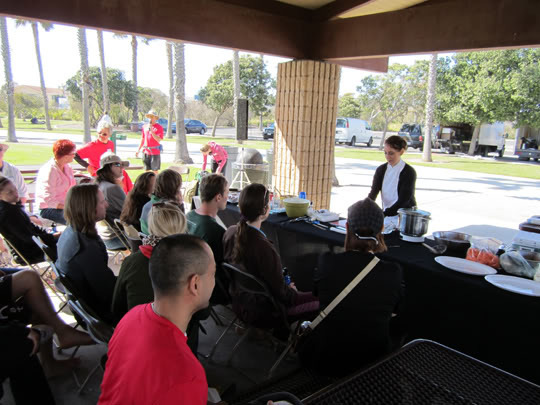
Workouts will take place on the Camp Richardson beach, in the water, or at a nearby high school athletic field (or gymnasium in the event of inclement weather). Experts in Primal Blueprint Fitness will guide you in small groups with sessions designed to educate and invigorate you without risking overstress or injury. Again, this conference is for absolutely everyone. Whether you’re in great shape, or you’re injured, relatively unfit, or unfamiliar with the Primal Blueprint, this weekend can kick-start a brand new way of life!
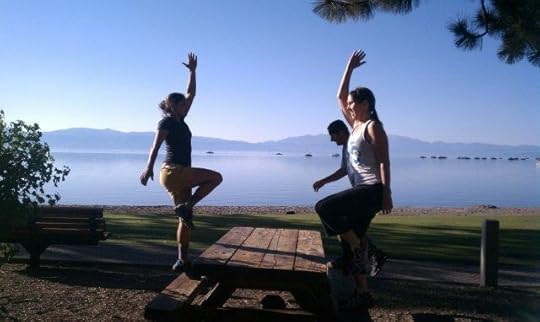

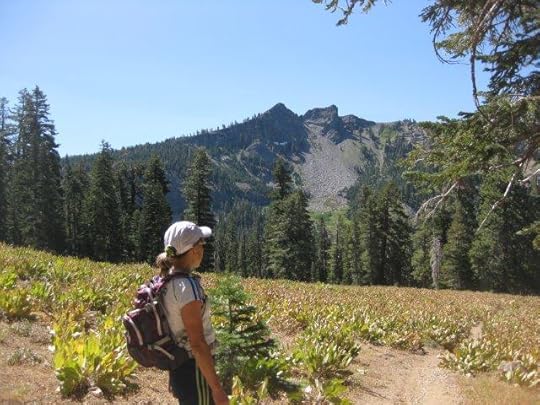

PrimalCon Tahoe staffer Colleen Conners-Pace works with her weekly boot camp at Lake Tahoe
We’ll have all kinds of fun, games, and relaxation, including a spectacular hike to the secluded Angora Lake, with an easy option (2 miles roundtrip, 250’ elevation gain on a wide, smooth trail) and a challenging ridgeline ascent option (2.8 miles, 1,250′ elevation gain); a spectacular luxury yacht sunset cruise to world-famous Emerald Bay; kayaking and standup paddling at Lake Tahoe; Ultimate Frisbee matches; and free time for small group engagement with the presenters of your choice (wanna learn to tightrope-walk?).

Visible in foreground is the Upper Angora lake (hike finish). Just behind is Lower Angora lake (short hike start). Behind that is Fallen Leaf lake (long hike start), with expansive Lake Tahoe just behind Fallen Leaf lake in background.
We’ll have lavish Primal feasts featuring ridiculously colorful and enticing lunch and dinner buffets from our same chef from Oxnard, David Aflalo of Above and Beyond Catering. Enjoy an amazing assortment of fresh-cooked, locally grown, pasture-raised, premium quality Primal offerings. Linger after dinner for social time as the spectacular Tahoe sunset marks the end of the day. We’ll then convene at Camp Richardson’s fantastic camp fire facility (seats 100+!) and bust out the wine and exquisite dark chocolate from Ethereal Confections and Santa Barbara Chocolate Company.
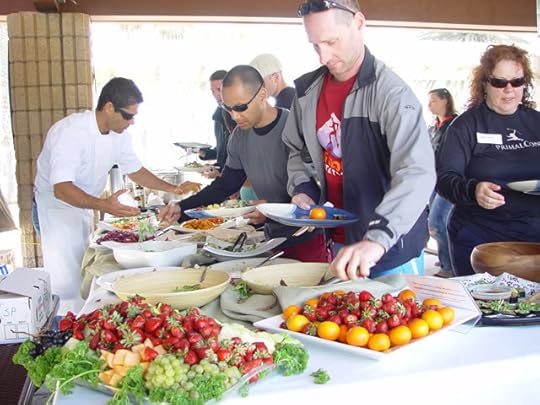

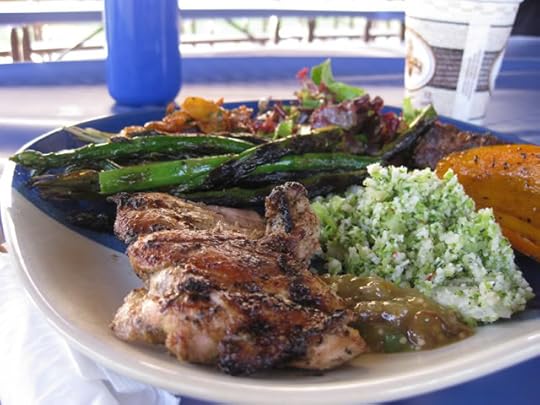
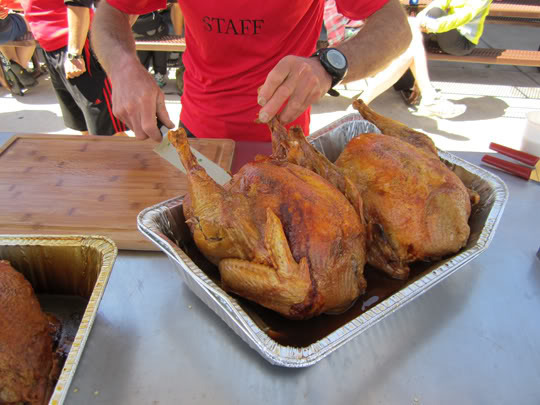
While Oxnard has the now world-famous Primal ocean plunge (watch it here), Tahoe will raise you one with the Upper Angora Lake cliff jump! No, not the 70-foot perch favored by local daredevils (makes for fun spectating), but rather a 9-foot option for newbies, or a thrilling 20-foot option for the more adventurous and experienced.
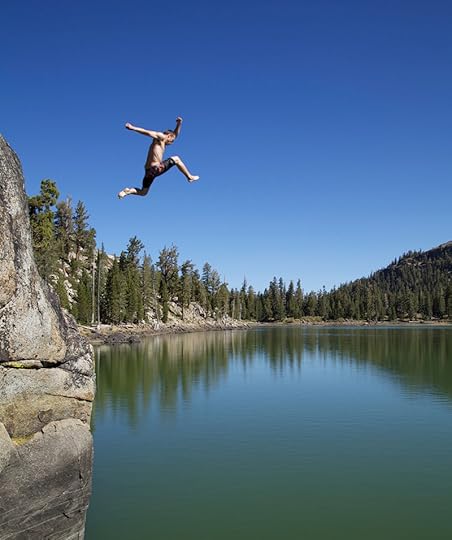
Photo Credit: Tahoe Mountain Sports
Guest Presenters
In addition to me, we have a stacked presenter list for PrimalCon Tahoe 2013 featuring numerous leaders in the field and members of the Mark’s Daily Apple community:

Robb Wolf: As one of the leading voices of the Primal/paleo/evolutionary health movement, Robb is a busy guy and a highly sought after speaker across the globe. However, Robb, like you, has been reading the blog, looking at the pics and videos, and pining to attend PrimalCon for a couple of years now. Well, he’s finally going to make it work in 2013. And I must say, if someone as busy as Robb can carve out a few days for fun in the mountains, so can you! I’m incredibly stoked to welcome Robb and am sure he will be a huge hit. Regarding his participation, Robb and I decided to just turn him loose and let him do what he does best – riff on any and all matters of Primal living that you can conjure up to ask him.
Robb is the author of the bestselling The Paleo Solution: The Original Human Diet. He publishes a popular blog at RobbWolf.com and hosts a popular weekly Internet podcast called The Paleo Solution together with Greg Everett of Catalyst Athletics. Robb has functioned as a review editor for the Journal of Nutrition and Metabolism, is co-founder of the nutrition and athletic training journal, The Performance Menu, co-owner of NorCal Strength & Conditioning, one of the Men’s Health “top 30 gyms in America” and co-owner of Evolve Foods a paleo food company selling meals and snacks featuring grass fed meat, wild caught fish and all organic ingredients.
Robb is a former California State Powerlifting Champion (565 lb. Squat, 345 lb. Bench, 565 lb. Dead Lift) and a 6-0 amateur kickboxer. He coaches athletes at the highest levels of competition and consults with Olympians and world champions in MMA, motocross, rowing and triathlon. Wolf has provided seminars in nutrition and strength & conditioning to various entities including NASA, Naval Special Warfare, the Canadian Light Infantry and the United States Marine Corps. Robb lives just down the hill from Tahoe in Reno, Nevada with his wife Nicki and daughter Zoe.
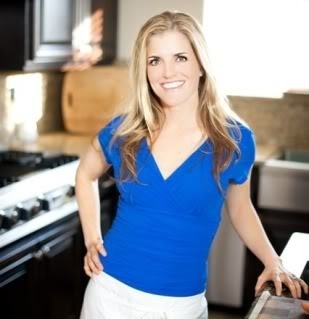
Sarah Fragoso is author of the national best selling books, Everyday Paleo, Paleo Pals: Jimmy and the Carrot Rocket Ship, and the Everyday Paleo Family Cookbook. Sarah is a strength and conditioning coach for Norcal Strength and Conditioning in Chico, CA, one of Americans top 30 gyms. She hosts a podcast called “Paleo Lifestyle and Fitness Podcast” at her website Everyday Paleo, conducts nationwide seminars, works directly with the Naval Special Warfare community teaching nutrition classes, and contributes to several publications and blogs regarding how to successfully introduce and maintain the paleo lifestyle for families. Sarah will discuss how to smoothly transition your entire family to a Paleo diet and lifestyle and her success story of transitioning out of poor health to become America’s #1 Paleo mom.

Chrissy Gower: Chrissy will present together with her frequent speaking partner and Paleo Talk podcast co-host Sarah Fragoso about how to get families eating and living healthy! Chrissy, sister-in-law of Robb Wolf, is a hard working wife and mother of two that is committed to educating families on how to live a healthier lifestyle. As a personal trainer out of the famed NorCal Strength and Conditioning gym in Chico, CA, she has helped countless individuals and families successfully implement a paleo diet and age-appropriate fitness programs. She also runs the acclaimed blog, Growing Up Paleo.

Katie Deluca hails from Chico, Ca where she was Strength and Conditioning coach under the tutelage of Robb Wolf and Nicki Violetti for over 6 years. She holds a BA in Kinesiology as well as numerous certificates in Weight Lifting, CrossFit, and Nutrition. She has been featured internationally as a fitness model in Mark Rippetoe’s Starting Strength DVD, The Paleo Solution, Power, Speed, Endurance, and Fitness Rx for Men – March 2012-April 2012 – as (Olympic Lifting Model.) Master of all things glute related, be sure to pick her brain on glute activation and how it relates to strength and conditioning. You can check out her musings on life, travel, and training at www.KDDeLuca.com. Katie will be presenting with Adam and Vanessa Lambert on Olympic Lifting and Gymnastics.
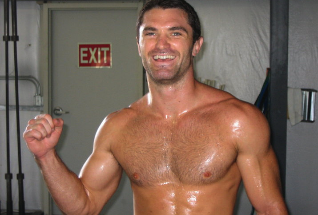
Glen Cordoza has written 17 books on MMA, Brazilian Jiu-jitsu, Muay Thai kick-boxing, and fitness, as well as co-authored with Kelly Starrett the long-awaited Becoming a Supple Leopard. Glen has an 8-0 record in professional Thai boxing, a 3-1 professional MMA record, and holds the rank of Purple belt in 10th Planet Jiu-Jitsu. Glen worked as a trainer at NorCal Strength and Conditioning and does online consulting at RobbWolf.com. Glen will present Olympic Lifting and Gymnastics alongside Adam and Vanessa Lambert at PrimalCon. He will also be available to take questions and provide insight into the world of Muay Thai and MMA fighting for those interested in this discipline.
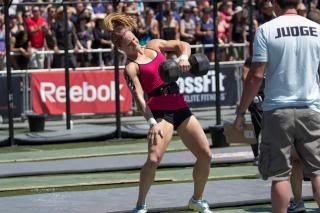
Jenny LaBaw is one of America’s leading CrossFit Games competitors. After a collegiate soccer and track career, Jenny took 6th place at the 2011 Reebok CrossFit Games in her first year in the sport! She followed up with a 2012 victory in the NorCal regionals. Jenny is a coach at NorCal Strength and Conditioning in Chico, CA and spends her spare time hiking, running, mountain biking, paddle boarding, skiing, camping, fishing, hunting and just being with her boyfriend and two yellow labs. She’ll be available at PrimalCon to work with guests who harbor competitive aspirations, as well as casual fitness enthusiasts looking for more guidance and inspiration from a true champion. Check out Jenny’s amazing video here.

Angelo dela Cruz: Angelo is simply the all-around all-star of PrimalCon. He gets our days off to a great start with his morning sessions of Vitamove (an energizing/focusing mix of tai chi and stretching), and no doubt will be goaded into ending our days in style by busting out some of his break dancing moves at the beach party house! Angelo will engage with groups large and small to dispense his unique wisdom and instruction in the areas of parkour/freerunning, gymnastics, and martial arts. Angelo is also an expert healer and will be available for 1:1 stretching/massage realignment sessions during presenter free time. To get a sense of Angelo, check out his ninja warrior audition tape!

Darcy Norman: Darcy is a licensed physical therapist, certified athletic trainer, and certified strength and conditioning specialist. He is an internationally recognized athletic performance and rehabilitation expert, and has worked with the top professional soccer team FC Bayern Munchen, and the HTC Highroad Pro Cycling Team. Darcy received degrees in Physical Education and Biology with an emphasis in Athletic Training and Pre-Med from Washington State University and a degree in Physical Therapy from the University of Washington. Darcy will discuss functional biomechanics and pre- and post-rehabilition testing to help fitness enthusiasts of all levels train effectively, recovery quickly and prevent injury.

Marcus Brown is a global water skiing icon: University World Champion, Australian Moomba Masters Champion and U.S. Open Champion. He is currently a water skiing ambassador to the United States Olympic Committee. A professional athlete for most of his adult life, Marcus has developed a mental, emotional, and physical regimen to prepare himself and many elite level athletes for competition. He will share his preparation and mindset tips for peak performance at PrimalCon.

Amy Kubal is a Registered and Licensed Dietitian specializing in the Paleo Diet and performance nutrition. She received both her Bachelors and Masters degrees in Nutrition from Colorado State University. She currently works with athletes and individuals looking to improve their overall health and performance through diet and lifestyle. Amy is the consulting dietitian for Robb Wolf and the director of Robb’s Paleo Physicians Network. Additionally she is the nutrition guru for the Whole9, and dietitian for Joe Friel’s TrainingBible coaching. Amy has helped many clients optimize body composition and/or manage and recover from autoimmune and diet related diseases: cancer, diabetes, heart disease, IBS, renal failure, lupus, and more. Additionally, she works with a broad range of performance focused clients made up of Olympic athletes, Ironman triathletes, professional bikers, marathoners, CrossFit games competitors, MMA fighters, Kettlebell masters, and every day athletes.
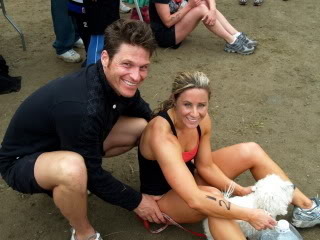
Vanessa and Adam Lambert will be teaching the fundamentals of Olympic lifting and Gymnastics. Vanessa, AKA Nesta Rae, one of Primal Blueprint’s own, has been a gymnast and competitive athlete her entire life (fitness reel). Adam is Battalion Chief and Physical Fitness Coordinator for Cal Fire. The two have been CrossFit games competitors (3rd place Affiliate team 2009), surfers, and avid Primal advocates for years. If you have ever heard of Olympic lifting and have wanted the opportunity to explore this ancient craft of weightlifting, or if you are an avid O-Lifter and just want to throw some weight around, you can join Adam and Vanessa during one of your elective hours to do so! The Lamberts will also be offering an elective that focuses on the fundamentals of gymnastics. Come improve your hand stand technique, learn to do a forward roll, or simply learn some gymnastic-based calisthenics. This is a great opportunity to explore gymnastics and its application to the Primal world.

Monisha White: Monisha joins us again to present Esther Gokhale’s posture and movement technique. Monisha was such a huge hit in 2012 she almost, almost makes people forget about her mom—that’s right, it’s Esther! A lifelong (literally!) student of the Gokhale Method, Monisha is an extremely polished and passionate presenter. She will take a weekend break from her classes at Stanford to deliver her formal presentations and engage 1:1 with guests to fine tune the way the they stand, sit, and move. Oh, did I mention her participation in the Ultimate Frisbee matches? Words simply do not do justice – this girl gets more air time than Michael Jordan! Don’t let the sweet smile fool you, pick her first for your team….she’ll be the one throwing, running, and catching with perfect technique.
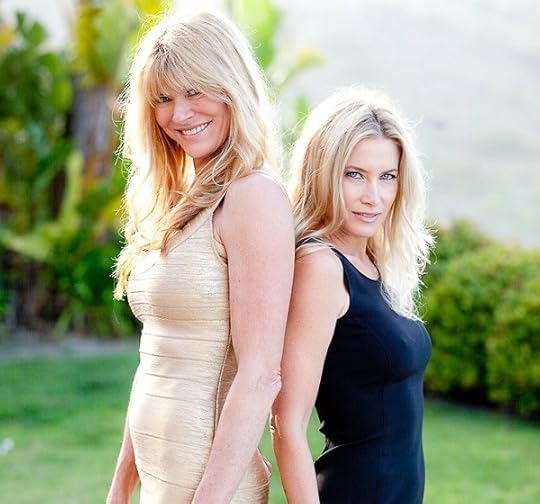
Carrie Sisson and Karen Moore: Carrie and Karen will present their popular Women’s Chat Group, a casual gathering to discuss any and all issues related to being female, being Primal, and living life to the fullest.
With Carrie’s plans rolling for a new Primal Woman book, there will be plenty of opportunity to engage on matters such as how Primal living can help you age gracefully, both in the mind and the body, raising a family, making a contribution beyond family, and female health-related topics.

Tyler and Connor Curley: PrimalCon veterans will hold court on the slackline in their native environs of the Sierra. These entertaining characters more closely resemble Grok than any other present day humans. While they shoulder some heavy staff duties, they will also show you how to play hard with slackline instruction, Ultimate Frisbee domination and maybe even an impromptu cold plunge off the luxury yacht in Emerald Bay – towel-off optional.
Getting Down to Details
Fees: $849 conference registration
Return-attendee discount: $100 discount to 2010, 2011, 2012 or 2013 PrimalCon Oxnard registrants. Type “PrimalConAlum” in the discount coupons field to activate. We’ll confirm your past participation upon receipt of 2013 registration.
Couple discount: $50 discount for couples, or pals, registering together – just select quantity “2″ for PrimalCon registration and you’ll receive $25 off each registration.
Cancellations: $100 cancellation fee (remainder refunded) if you cancel before June 30, 2013. $150 fee if you cancel after 7/1/2013.
Schedule: Thursday evening, September 26 – Primal Dinner Feast and social mixer from 6:00 pm to 8:00 pm. Friday morning, September 27 – registration 7:30 am, and then we jump right into the agenda. Well wrap up on Sunday at noon so you can embark on your journey home…and show up to work Monday morning a new person!
Testimonials
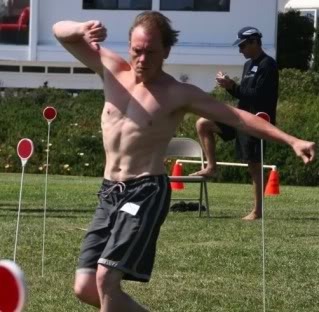 “I’ve been fortunate enough to attend three PrimalCons, and they just keep getting better each year. The food is mind-blowingly fantastic, an endless cornucopia, proof to those who need it that the world’s healthiest foods are also the tastiest. The presenters are fascinating, pioneers in their disciplines and deeply inspiring. And of course the attendees are no less remarkable. New friendships are guaranteed to be made, and there’s an ineffable sense of family from the very first night. PrimalCon is far and away the most exciting and delightful event of the year for me.”
“I’ve been fortunate enough to attend three PrimalCons, and they just keep getting better each year. The food is mind-blowingly fantastic, an endless cornucopia, proof to those who need it that the world’s healthiest foods are also the tastiest. The presenters are fascinating, pioneers in their disciplines and deeply inspiring. And of course the attendees are no less remarkable. New friendships are guaranteed to be made, and there’s an ineffable sense of family from the very first night. PrimalCon is far and away the most exciting and delightful event of the year for me.”
Timothy Williams
Los Angeles, CA – 3-time PrimalCon alum and sledgehammer presenter, and 21-Day Total Body Transformation success story
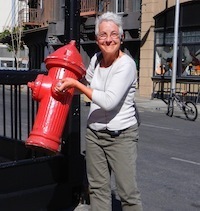 “I have to admit that I was a little leery about attending my first PrimalCon – shades of the first day of school for the new kid in town. But I’m soooo glad I went. It was a great weekend full of unique experiences and wonderful Primal people. And don’t forget the fabulous food! I learned so much, both from the knowledgeable and skilled presenters and from fellow attendees. I came away completely energized and even more committed to the Primal life. If anyone has doubts about whether they should attend, I say GO!”
“I have to admit that I was a little leery about attending my first PrimalCon – shades of the first day of school for the new kid in town. But I’m soooo glad I went. It was a great weekend full of unique experiences and wonderful Primal people. And don’t forget the fabulous food! I learned so much, both from the knowledgeable and skilled presenters and from fellow attendees. I came away completely energized and even more committed to the Primal life. If anyone has doubts about whether they should attend, I say GO!”
Marianne Callum
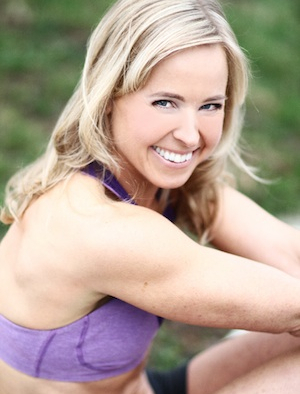 “I have been following MDA for the past year and a half and the conference was an event I was looking forward to to help me expand on the primal lifestyle in a hands on kind of way. With all the uniquely different presenters, I was able to refine what information I wanted to learn the most and hone in on that area. Mark really knows how to embrace his followers by sincerely interacting with everyone throughout the event. It was a joy to meet him in person and hear him speak to the group. He is a true pioneer and a great leader in the health and wellness industry. Thanks for everything you do, Mark!”
“I have been following MDA for the past year and a half and the conference was an event I was looking forward to to help me expand on the primal lifestyle in a hands on kind of way. With all the uniquely different presenters, I was able to refine what information I wanted to learn the most and hone in on that area. Mark really knows how to embrace his followers by sincerely interacting with everyone throughout the event. It was a joy to meet him in person and hear him speak to the group. He is a true pioneer and a great leader in the health and wellness industry. Thanks for everything you do, Mark!”
Tracy Barrett
 “What makes an Aussie travel over 7,000 miles to attend PrimalCon? The chance to learn, get personal advice and just hang out with a dream list of primal/paleo experts and enthusiasts… It’s the ultimate Primal Masterclass! I came away with new knowledge, new friends, refreshed inspiration and confidence and a few aching muscles that I never knew I had! I even made a new friend who lives in my city back in Australia, what were the chances of that??
“What makes an Aussie travel over 7,000 miles to attend PrimalCon? The chance to learn, get personal advice and just hang out with a dream list of primal/paleo experts and enthusiasts… It’s the ultimate Primal Masterclass! I came away with new knowledge, new friends, refreshed inspiration and confidence and a few aching muscles that I never knew I had! I even made a new friend who lives in my city back in Australia, what were the chances of that??
I’d recommend PrimalCon to everyone from committed ‘experts’ to those that have barely dipped a toe in the water; regardless of your experience you’ll come away with immediately applicable practical knowledge and skills to improve your quality of life. Bring on PrimalCon 2013!”
Jennifer Cook
Sydney, Australia

November 20, 2012
Alcohol: The Good and the Bad
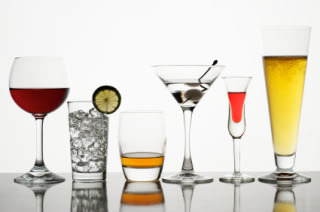 What do we make of alcohol? In sufficient amounts, it’s a poison. It’s incredibly addictive. It destroys entire communities. It tears families apart and compels otherwise reasonable, upstanding individuals to commit terribly senseless acts. On the other hand, it’s a powerful social lubricant. The good stuff tastes great and can enhance the healthfulness of certain foods while inhibiting the unhealthfulness of others. It’s fun, it’s pleasurable, and it brings real (if chemically enhanced) joy to people. Moreover, we have a long and storied history with alcohol; it’s been an integral part of human culture and society for thousands, if not tens of thousands, of years.
What do we make of alcohol? In sufficient amounts, it’s a poison. It’s incredibly addictive. It destroys entire communities. It tears families apart and compels otherwise reasonable, upstanding individuals to commit terribly senseless acts. On the other hand, it’s a powerful social lubricant. The good stuff tastes great and can enhance the healthfulness of certain foods while inhibiting the unhealthfulness of others. It’s fun, it’s pleasurable, and it brings real (if chemically enhanced) joy to people. Moreover, we have a long and storied history with alcohol; it’s been an integral part of human culture and society for thousands, if not tens of thousands, of years.
So, what’s the deal? Is it good, or is it bad? Is it poison, or is it a gift? Let’s take a look at both sides of the story, which, as is often the case, isn’t exactly black and white:
First, the downsides.
It’s toxic.
Our ability to break alcohol down into less toxic metabolites didn’t arise because of our tendency to seek out fermented fruits. Over the course of an average day, the average human digestive system produces about three grams of ethanol just from the gut flora fermenting the gut’s contents. If we didn’t have the ability to metabolize and detoxify ethanol, those three grams would add up real quick and represent a huge toxin load on our bodies. After alcohol is consumed, a number of enzymatic reactions ensue. In the liver, an enzyme called alcohol dehydrogenase converts the ethanol to acetaldehyde, an incredibly toxic compound that’s been implicated in causing many hangover symptoms. An enzyme called acetaldehyde dehydrogenase converts the acetaldehyde into acetic acid, or vinegar (which is harmless unless you’re a cucumber). From there, you’re good to go. Sounds simple enough, right? Just let the enzymes do their thing. As long as you make those enzymes, the alcohol will be safely and effectively metabolized into table vinegar which can then be extracted to form a delicious salad dressing (that last part isn’t true).
Unfortunately, not everyone produces the same amount and quality of detoxifying enzymes. Many people of East Asian descent possess a dominant mutation in the gene that codes for aldehyde dehydrogenase, making it less effective. While they’re less likely to be alcoholics, folks with the mutation (characterized by a “flushing” upon ingestion) are at an elevated risk of liver damage and esophageal cancer.
It can give you fatty liver (and worse).
Around these parts, we usually talk about non-alcoholic fatty liver, a disease associated with sugar and fat intake coupled with inadequate choline to support the liver’s function. But notice that we have to qualify it with “non-alcoholic.” That’s because the most-studied type of fatty liver is alcoholic fatty liver. The mechanisms behind alcoholic fatty liver are myriad and multifaceted, but it ultimately comes down to the fact that you’re bathing your liver in a known toxin. Liver alcohol metabolism increases the NADH/NAD+ ratio, thereby promoting the creation of liver fat cells and a reduction in fatty acid oxidation; the result is added fat in the liver and impaired fat burning. Acetaldehyde, especially if it lingers for too long, also induces inflammation in the liver, which can ultimately progress to full cirrhosis and liver failure.
It can be carcinogenic.
Excessive alcohol intake is an established epidemiological risk factor for several cancers, including stomach, liver, and colon cancer (to name just a few; more than a dozen cancers are linked to alcohol abuse). In the stomach and liver, alcohol dehydrogenase converts ethanol into acetaldehyde, which is inflammatory and toxic. Alcohol that makes it through the stomach into the small intestine is also oxidized into acetaldehyde, this time by gut flora. While the liver produces the necessary enzymes to break down acetaldehyde into acetic acid, our gut microbes aren’t so well equipped and the acetaldehyde is allowed to linger longer.
It’s addictive.
While I’d argue that being addicted to anything will have a negative effect on your life, if not your physical health, being addicted to alcohol is particularly harmful because of how toxic it is – especially the more you drink. To get an idea of just how addictive it is, check out the results of this study: alcohol is less addictive than nicotine, crystal meth, and crack, but more addictive than heroin, intranasal amphetamine, cocaine, and caffeine. One’s susceptibility to alcohol addiction is often hereditary, too, meaning some people will be far more likely to become addicted than others.
It disrupts sleep.
A nightcap is a misnomer. Sure, it’ll help you fall asleep, but your sleep won’t be any better. In fact, as plenty of people reminded me in the comment section of last week’s post on sleep, alcohol is a serious disrupter of sleep quality. It increases the incidence of sleep disruptions, and it perturbs the healthy sleep cycles.
It affects judgment and perception.
Even though alcohol destroys a person’s ability to safely maneuver a motor vehicle, one in three car accidents that result in death involve drunk drivers. Everyone knows that you shouldn’t drive drunk, but why does it keep happening? A recent study even showed that just a single drink caused subjects to find “intentionality” in other people’s actions (PDF). Subjects who got the alcohol were less likely to view simple actions as accidental, rather than intentional. Thus, when you’re under the influence of alcohol, you’re more likely to take personal offense at the guy bumping into your shoulder, the lady stepping on your shoe, or the person “staring” at you from across the bar. Because, after all, they “meant” to do it, right? The title of the study sums it up quite nicely: “‘There’s No Such Thing as an Accident,’ Especially When People are Drunk.”
It promotes bad eating.
Everyone who’s ever gotten at least a buzz from a glass or two of wine or a mixed drink has felt the often irresistible urge to snack, to order something salty, crunchy, and sweet from the menu, to beg the driver to swing by the greasiest nastiest fast food drive-thru. This is a well-documented phenomenon. Alcohol affects both active overeating and passive overeating. Active overeating describes the conscious decision to “get some grub.” Passive overeating describes the amount you eat once the food is in front of you. Both are enhanced by alcohol. This wouldn’t be such a bad thing if you’re drinking at a Primal meet-up, where you’re surrounded by relatively healthy food, but that’s not where most drinking occurs.
It gives hangovers.
What’s worse than a bad hangover? I’m unaware of anything, at least on a physical scale. Sure, you can mitigate the damage, but the fact that a hangover even exists tells us that whatever we’re ingesting that gave us the hangover is bad for us (in the amount we ingested, at least).
But what about the positives?
It improves endothelial function (with a catch).
Impaired release of nitric oxide from the endothelial cells is strongly associated with cardiovascular disease. Ethanol actually increases the production of nitric oxide, which dilates blood vessels, regulates blood pressure, induces vascular smooth muscle relaxation, and basically improves endothelial function. If you want good cardiovascular health, you want good endothelial function. However, it’s important to note that large doses of ethanol seem to decrease endothelial function, so caution is obviously warranted.
It can reduce stress.
A lot of people use a glass of wine or beer to “wind down” after a hard day. This sounds bad on the surface – “you’re relying on alcohol to stay sane!” – but really, if you have to choose between stewing in your stress hormones all day and night and having a drink or two to settle yourself down, I think the drink can be a better option for some people – particularly if the stress is going to impair your sleep and affect your relationships. You’ll want to identify and deal with the original source of the stress, of course, but some people may find a net benefit from having that drink.
It promotes socializing.
Humans are social animals, and we are happiest and healthiest when we have friends, loved ones, and spend quality time with them. Social isolation is a consistent and strong risk factor for increased mortality and morbidity (meaning it’s linked with earlier death and worse health in the days up until that death). You shouldn’t base your socialization entirely on drinking alcohol, but it can certainly be a powerful enhancer of your social life, and if you’re having a couple of glasses of wine as you host dinner parties, hang out with friends, enjoy a candlelit dinner with your significant other, or throw a BBQ with your social circle, it will likely have a net positive effect on your health. Of course, this isn’t to say that alcohol is any way needed to have a good time in a social setting.
It can reduce post-prandial blood sugar and lipid peroxidation (when taken with a meal).
Just like it says above, drinking alcohol (like wine, for example) with food can reduce postprandial blood glucose and the susceptibility of blood lipids to peroxidation (PDF).
It can lower iron absorption if you’ve got iron overload.
Although the conventional push is to increase the intake of iron from foods (especially via fortified grains), some people don’t actually need the added iron. If you have hemochromatosis, a genetic condition that probably arose in Europeans as a survival response to the bubonic plague, you are a hyper-absorber of dietary iron. Luckily, ethanol seems to inhibit the absorption of heme iron, the kind you find in red meat. Red wine is also effective at reducing non-heme iron absorption, an effect most likely due to the polyphenols present. That said, the entirely non-alcoholic black tea also inhibits iron absorption and has even been shown to reduce the frequency of blood-draws required in patients with iron overload. Coffee works, too.
If you’re going to drink:
Have it with food.
When you eat a meal, and your stomach is “full,” the pyloric sphincter – which controls the passage of food and drink from the stomach into the small intestine – closes up until your stomach can break down its contents. Any alcohol added to a full stomach will also spend more time being broken down by the relevant enzymes. If you drink on an empty stomach, the pyloric sphincter is wide open, and a greater proportion of alcohol will make it to the small intestine for immediate absorption. Plus, as I mentioned earlier, drinking alcohol with food can reduce postprandial blood glucose and the susceptibility of blood lipids to peroxidation (PDF). Keeping your drinking around meals will let you take advantage of these benefits.
Focus on alcoholic drinks with greater fluid content.
Shots of plastic bottle vodka (or even the best vodka) are concentrated sources of ethanol, and as long as we’ve been nibbling on fermented fruits and brewing up Paleolithic moonshine from mushrooms and honey, consuming concentrated, distilled ethanol in the form of rum, gin, whiskey, vodka, and other hard liquors is a relatively recent practice. Some accounts suggest that the Chinese were distilling rice liquor in 800 BC, while others say it wasn’t until the 12th century AD that distillation became commonplace across the “known” world. At any rate, one could certainly argue that alcohol with a low fluid content is an evolutionarily novel food item. Less fluid means less “stuff” in your stomach, which means a more open and allowing pyloric sphincter, which means faster absorption through the small intestine. More fluid means more “stuff” in your stomach and a more restrictive pyloric sphincter and slower absorption. You could even make like the ancient Greeks and water down your wine, which some people seem to think actually improves the wine.
Choose your drinking companions wisely.
Even among voles, peer pressure-induced binge drinking is a reality. If that super cool vole with the sweet facial hair is double fisting acorn shells filled with dandelion wine, you’ll be subconsciously drawn to do the same. If your group of friends gets absolutely obliterated every time you go out with them, you’re more likely to join in on the “fun.”
Drink moderate amounts.
All the research suggesting health benefits to drinking revolves around “moderate drinking,” which is one, two, or three drinks a day. They’re not talking about pounding shots, or drinking Long Island iced teas, or doing Jello shots (although the gelatin might help matters). They’re talking about a glass or two of something.
Have everything else in line.
If you want to drink and remain healthy, you should strive to eat healthy, exercise well, reduce stress, walk a lot, experience nature, hang out with friends and loved ones, get sun when available, avoid nighttime light exposure as much as possible, and every other lifestyle prescription I recommend. In short, alcohol can augment (or at least fail to impact either way) an already healthy lifestyle, but it probably won’t make a bad situation better.
Full disclosure: I drink. My drink of choice is red wine, and I might do a glass or two most nights, but I never get drunk. Heck, I don’t even really get “buzzed.” I’d never recommend that people take up drinking or continue drinking, but I also don’t see it as a great evil in and of itself. The dose and frequency make the poison; it’s just that depending on a number of factors, the dose that makes alcohol a poison might be lower or higher for you than for me. If your sleep is affected or you are the least bit “off” the next day, you probably surpassed your ability to effectively process it and you should factor that in to your choice and approach to drinking again. And remember, alcoholism is a serious issue for some people and I am in no way suggesting there is any “workaround” or excuse herein for someone with those issues, or that drinking, even in moderation, is necessary or optimal for healthy living.
Okay, that’s about it for me. Let’s open it up to you guys, now. I want to hear your thoughts on alcohol, especially whether it’s had a positive, negative, or neutral effect on your life and the life of those you care about. I want to hear how you’ve integrated alcohol into your otherwise healthy lifestyle (or not). Thanks for reading!
Grab The Primal Blueprint Cookbook Today and Receive Free S&H and a Free Primal Blueprint Poster

November 19, 2012
Dear Mark: Wheat and Asthma, Minimalist Winter Shoes, High-Fat Rat Cognition Study, and Sun Exposure Timing
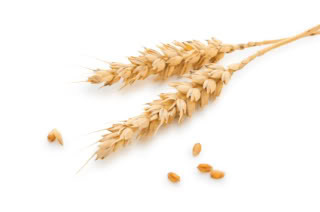 Today’s edition of “Dear Mark” runs the gamut. The topics will be somewhat familiar, since I tackle wheat, minimalist shoes, high-fat diets in the news, and vitamin D, but with interesting spins on each. First, I discuss the link between wheat and asthma. Next, I do a somewhat exhaustive search of the available winter minimalist shoe options, a topic that I’ve never had cause to explore for myself. Since I do this for you guys, though, I tried to help out. After that, it’s my quick but (in my mind) pretty conclusive take on the latest article to pin cognitive decline on a high-fat diet for a reader who’s dealing with a similar condition herself (or himself; the gender of the name “Jo” is somewhat ambiguous). And finally, I discuss whether or not there’s a best time of day to obtain vitamin D from the sun.
Today’s edition of “Dear Mark” runs the gamut. The topics will be somewhat familiar, since I tackle wheat, minimalist shoes, high-fat diets in the news, and vitamin D, but with interesting spins on each. First, I discuss the link between wheat and asthma. Next, I do a somewhat exhaustive search of the available winter minimalist shoe options, a topic that I’ve never had cause to explore for myself. Since I do this for you guys, though, I tried to help out. After that, it’s my quick but (in my mind) pretty conclusive take on the latest article to pin cognitive decline on a high-fat diet for a reader who’s dealing with a similar condition herself (or himself; the gender of the name “Jo” is somewhat ambiguous). And finally, I discuss whether or not there’s a best time of day to obtain vitamin D from the sun.
Let’s get going:
Mark,
I love the website and your books. I have been eating paleo for the past 4 months and notice a huge difference in my athletic performance and general out look on life. I have suffered from asthma my entire life. After eating a sandwich made with french bread (refined wheat) or a plate of pasta (which is rarely now), I find my breathing slightly labored even while sitting. Is there any research supporting the removal of gluten and wheat help asthmatics?
I would love to know you thoughts…
Drew
I think so, yes. Something called baker’s asthma, which has been identified since at least the 1700s and is exactly as it sounds, is linked to the ingestion (this time via the clouds of airborne flour to which bakers are constantly exposed) of gliadins, the protein subfractions that make up gluten.
There’s also a related condition called wheat-dependent exercise-induced anaphylaxis where wheat-related proteins make it through the intestinal wall into the blood and cause an immune response that manifests as an asthma attack. It’s “exercise-induced” because exercise seems to speed up the rate at which the wheat gliadins make it into the blood, but even those at rest had evidence of an immune response to the gliadins.
There’s also evidence of plain-old wheat-induced asthma – no exercise necessary.
I’d say you’re on to something, Drew. You can keep experimenting if you like, but I’d suggest just staying away from the stuff myself! Good luck!
Hey Mark. I’m very addicted to my Vibrams, and with this nor’easter coming through I had to go back to my winter boots, and while they do keep me dry and warm, I’m hating it!
Tried looking through the site but didn’t find anything as far as some type of minimalist shoe for winter? Any recommendations?
Wish Vibrams made a winter type shoe. I see they used to make one that kind of looks like it would be helpful, but they don’t sell it anymore.
Thanks!
Jason
I share your addiction. For folks who actually have real seasons with a real winter, the minimalist winter shoe is something of a white whale – an enigma hovering just out of reach, a product that you know should exist but that you can never actually pin down. I’ve never really looked into it for my own feet, since they rarely see cold weather, but let’s see what’s out there, yeah?
First, a quick glance at the minimalist wintery offerings from the well-known companies out there:
Merrell
Men – Nothing meant for winter that I could see.
Women – Barefoot Life Frost Glove: waterproof, insulated, Vibram sole.
Vivo Barefoot
Men – The Off Road Hi and Off Road Mid look to be decently protective options.
Women – They’ve got an entire winter boot collection for women, albeit a fairly small one.
Softstar
Unisex – Adult Phoenix Boot: sheepskin lining, 5 mm Vibram sole, lighter and more flexible sole as of 2012, roomy toebox (very important, in my experience, for true barefoot feel), naturally water-resistant.
Now, how about the shoe options that might not be officially minimalist but are close enough?
Russel Moccasin now makes a full lineup of minimalist moccasins, some of which are winter proof. They’ve been around for decades, so they should be pretty high quality.
Otz Shoes has a Troop Boot. It’s not billed or promoted as minimalist, but as this review from Birthday Shoes suggests, it can certainly be modified to become an effective, minimalist winter boot. They’ve got ‘em in women’s, too.
There’s an actual minimalist army boot out, as well – the Belleville Minimalist Training Boot. Read the review.
O’neill (yes, the surfwear company) makes a neoprene reef boot. Since it’s designed for water sports, it’s fairly water-resistant, and since it’s designed for cold ocean water, it’ll keep you warm. It’s also got good grip and the price is fantastic.
If you have a favorite barefoot shoe that isn’t quite protective or warm enough, you can always throw some overboots over your boots (or shoes). They work on hiking boots and shoes equally. Here’s another link. If you really want to stick with the FiveFingers and somehow stay warm, you could always wear them with some outdoor toe socks from Injinji.
That should do it. I hope you find something amidst all those links that works for you.
Hi Mark,
I’m an international fan — I live in Korea and have been reading your blog since February 2012. I first saw Dr. Terry Wahls’ TED talk “Minding Your Mitochondria” online, then went on vacation to Vietnam, where another tourist from Romania shared your website with me. So you have quite the far-reaching influence, and I now regularly quote you to friends from Korea, Canada, the US, and France, proselytizing as many as I can!
I even try to raise primal-related questions among my students at Seoul National University, where I teach English for Academic Purposes.
Anyway, I also happen to have been diagnosed with MS (technically Clinically Isolated Syndrome), but to make a long story short, although I recovered nearly fully from my first severe attack before going primal (basically by unwittingly doing everything in the primal lifestyle except the diet bit), I have felt even better since going grain- and refined sugar-free, and my most recent MRI even indicates likely re-myelination of the lesions in my brain.
So naturally, when I saw this article on the NY Times today – Can Exercise Protect the Brain from Fatty Foods? – I was skeptical, given that I have been eating a high-fat diet and have simultaneously (if not causally) seen “improvements” in my brain. I wondered what actual foods, in both the high-fat diet and the “conventional” one, they were feeding their lab rats, and if there is a chance that a high fat diet could, in fact, damage the brain. My personal guess is that it really depends on the type of fat…I would love it if you could share your take on this study.
Thanks for all the work you do,
Jo
Browse the comment section of that NY Times article and you’ll find that one commenter (Edward Barton) contacted the study’s lead author and found out that the fat in the diet “consisted exclusively of commercially produced (soy and corn derived) lard and soy oil.” As we now know, the lard used in refined lab diets is far higher in omega-6 than previously thought due to the modern pig’s usual diet, which consists of mostly corn and soy products. If you look at the USDA nutritional database, lard is pretty high in monounsaturated and saturated fats and low in polyunsaturated, but the actual lard used in lab diets contains twice as much PUFA.
Does this matter? I think it might. Previous studies have shown that among polyunsatuturated fats, only DHA, EPA, and arachidonic acid increase membrane fluidity in the brain while linoleic acid failed to increase it, a significant finding for two reasons. First, patients with Alzheimer’s disease tend to have far less membrane fluidity than control patients, and a fluid brain is required for optimal cognition. Second, the added PUFA in the industrial lard is almost entirely linoleic acid (not arachidonic acid), which the pigs obtain from the soy and corn in their diets and incorporate directly into their adipose tissue. If these rats were on a high linoleic acid diet – which they undoubtedly were – we would expect membrane fluidity and cognition to be impaired. No real surprise there.
Besides, you’re not a rat, you’re not eating rancid refined lard and soybean oil high in omega-6 fats, and you’ve actually made progress against your condition. I wouldn’t worry. It’s not like your brain’s apparent re-myelination is merely a feint in the right direction before it begins backtracking toward progression of the disease. Even if the mice were on a rodent version of a Primal eating plan, I wouldn’t worry purely on the strength of your own response to the diet and lifestyle changes. Heck, even if you were a rat that had somehow gained the ability to send emails and compose thoughtful, cogent prose, I’d say you should stick with what is obviously working for you even if the high-fat lab diet wasn’t working for your fellow rodents. The proof is in the pudding, especially if the pudding is in your bowl.
Mark, I have read your book. What time of the day is best for the skin to create vitamin D from the sun?
Suhas
Great question. The skin will make vitamin D from UVB exposure at whatever time of the day it receives it, so the real key is figuring out when UVB is out and about. That depends on where you are and what time of the year it is, of course, but for the most part, UVB peaks at solar noon, or whenever the sun is highest in the sky. If you’ve got a short shadow and the UV index is high enough, you’re probably making vitamin D.
However, there are other things to consider. Now, you may have gotten the impression that the sun is wholly our friend, that it can do no wrong, that skin cancer from too much sun is a myth. It’s not. The sun can damage our skin and, if enough accrues, it can cause cancer. Significant evidence from animal models suggests that sunning ourselves at the wrong time of day can make us more susceptible to skin cancer (PDF). To protect our skin from UV rays, we manufacture an endogenous compound called xeroderma pigmentosum group A, or XPA. XPA plays an important role in the repair of sun damaged skin, and it follows a circadian schedule. In other words, XPA isn’t just produced when you need it. It peaks at certain times of day. In mice, XPA peaked at 4 PM and dropped off at 4 AM; exposing them to UV at 4 AM gave them cancer fives times more frequently than exposing them to UV at 4 PM. For humans, XPA peaks in the morning at around 7 AM.
So, you can make vitamin D whenever the sun is strong enough, but you might want to consider your XPA levels, too. The rodents’ levels peaked at 4 PM and dipped immediately after, but they were still significantly elevated at 9 PM and totally tanked by 1 AM. If our XPA trajectory is similar, we should enjoy the most protection between 7 AM and noon, with the former time obviously offering the most protection. It’s also conceivable that all this gets thrown out the window if your circadian rhythm is messed up for whatever reason. Something to keep in mind, at the very least.
Hat tip to Jamie Scott for his excellent take on the paper.
Grab a Copy of The Primal Blueprint 21-Day Total Body Transformation and Start Getting Primal Today!

November 18, 2012
Weekend Link Love
 Research of the Week
Research of the WeekIn elite gymnasts, a three month stint on a very low carb ketogenic diet had no (negative or positive) effect on their performance and explosive strength levels. Gymnasts on the ketogenic diet, however, did lose a considerable amount of fat mass.
A new meta-analysis concludes that protein supplementation increases both strength and muscle mass in younger and older trainees engaged in prolonged resistance exercise.
Interesting Blog Posts
The Sock Doc breaks down how our hormones can affect the health and stability of our ligaments.
“It’s not me, it’s you,” said the venison to the finicky modern eater.
Media, Schmedia
Vote for Robb Wolf and Greg Everett‘s whole Paleo Solution podcast dealio gig in the People’s Choice Podcast Awards. Scroll down to Health/Fitness to cast your vote.
If any grain is Primal, it’s Paleo oatmeal, about as old fashioned as you can get (Onion warning).
Everything Else
Crossfit Endurance founder Brian Mackenzie details his training philosophy in the newly-released book with the self-explanatory title: Power, Speed, Endurance. If you’re a fan of endurance sports (or just general human performance) and you want to do them safely, effectively and healthfully, check out the book. Here’s a trailer, and here’s a sample chapter (PDF), free of charge.
And for the kids out there wondering what they should put on their feet to go run, here’s a possible answer.
Recipe Corner
Yeah, it’s a nut-meal based paleo treat that apes SAD food but so what? It’s the holidays: Paleo Sweet Potato Biscuits.
Just wrap it in bacon and they’ll never be the wiser.
Time Capsule
One year ago (November 18 – November 24)
The Problems with Antibiotics: More Fallout from Killing Your Flora – All the other downsides to antibiotics abuse that most people – even those who get it otherwise – don’t really mention.
The Problems with Antibiotics: Possible Alternatives and Damage Control – Assuming you do have a condition that calls for antimicrobials, are there any options besides antibiotics? And how can you reduce the collateral damage?
Email of the Week
I don’t know how ANY of the test subjects managed to fall asleep while researchers were taking their rectal temperatures.
- Different strokes, mattoomba. Don’t knock it til you’ve tried it.
Grab The Primal Blueprint Cookbook Today and Receive Free S&H and a Free Primal Blueprint Poster

November 17, 2012
Succulent Roast Goose
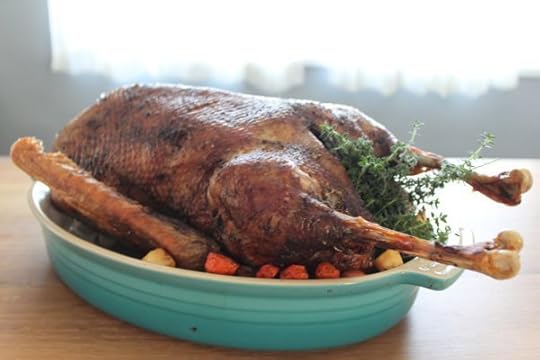 Roasting a goose makes any holiday feast merrier. Not only because it’s not the same old turkey or beef roast, but because goose meat is intensely meaty and flavorful and cloaked in a layer of unbelievably rich, crispy skin.
Roasting a goose makes any holiday feast merrier. Not only because it’s not the same old turkey or beef roast, but because goose meat is intensely meaty and flavorful and cloaked in a layer of unbelievably rich, crispy skin.
As an extra bonus, a goose also leaves behind a gift: lots of delicious goose fat. You’re likely to run out of the fat before you run out of ways to use it. Roast or sauté vegetables, pan-sear seafood, fry chicken, make duck or goose confit or chicken liver pate…the possibilities are endless. Rendered goose fat keeps for months in the refrigerator and up to a year in a good freezer.
Rendering the goose fat is an extra step in the cooking process, but an easy one. And after that, cooking a goose isn’t much different than cooking a turkey; in fact, it’s easier without all that dry white breast meat to worry about. Geese have dark meat throughout because they use their breast muscles regularly for flight. A goose is the perfect bird for real meat lovers. Close your eyes while eating roasted goose breast and you might just think you’re eating steak.
If cooking a goose seems daunting, don’t worry, it’s not. This recipe might look long, but only because it’s filled with lots of helpful tips. The process itself couldn’t be easier: season the goose, steam the goose in a roasting pan, roast the goose for several hours, then enjoy the feast.
Servings: Eight to Ten
Time in the Kitchen: Very little prep involved, mostly cooking time: One hour for steaming plus two to three hours for roasting (plus two full days beforehand to defrost a frozen goose in the refrigerator).
Ingredients:
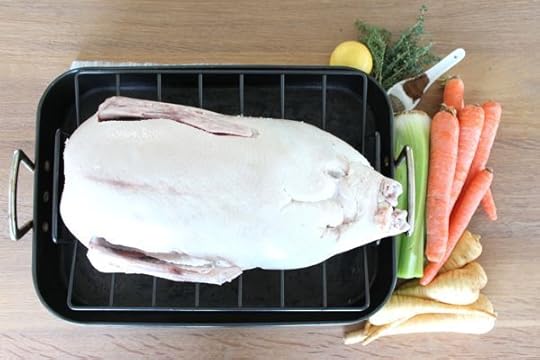
1 goose (12-14 pounds) wing tips cut off and neck and giblets and excess fat taken out of the cavity (5 to 6 kg)
3 teaspoons salt (15 ml)
1 teaspoon black pepper (5 ml)
1 teaspoon allspice (5 ml)
1 lemon, halved
8 sprigs of thyme
2 pounds of carrots, cut into 1-inch pieces (900 g)
1 bunch of celery (about ten stalks) cut into 1-inch pieces
1 1/2 pounds parsnips, cut into 1-inch pieces (680 g)
Instructions:
Allow two full days in the refrigerator for defrosting the bird if frozen.
Gently pull the skin away from the bird and prick the skin with a fork or skewer all over, being careful not to prick the meat. This helps the fat drain so the skin becomes crispier.
Mix together salt and pepper and allspice. Rub all over the bird then squeeze juice from the lemon all over the bird. Place the used lemon and the thyme in the cavity.
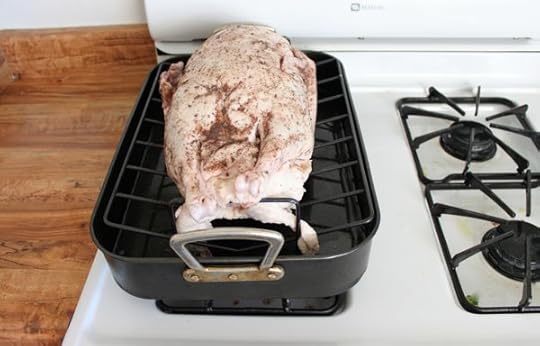
Add six cups of water and the neck and giblets to a deep roasting pan. Set the goose (on a rack) in the roasting pan, breast side up.
Cover the entire pan tightly with foil and set over two burners on the stove.
Bring the water to a boil. Reduce the heat to medium to keep the water at a simmer for one hour. This will steam the goose and render fat from the skin. Check the pan near the end of the hour to make sure all the water hasn’t evaporated; if the water level is getting low, just add another cup of water.
Uncover and remove the roasting pan from heat. Lift the goose and rack out of the roasting pan. Take out the neck and giblets (eat or discard). Pour the liquid in the pan through a fine mesh strainer into a heatproof bowl or measuring cup. As it cools, the pure fat will rise to the top. Skim or pour it off and save for future use. You should get several cups of fat.
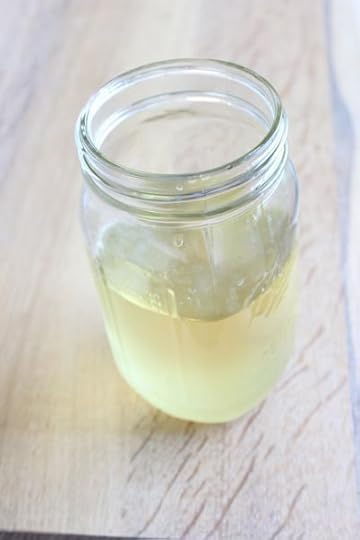
**Optional: For upping the odds of crispy skin, the steamed goose can be refrigerated, uncovered, on the roasting pan rack overnight. Bring the bird to room temperature again before putting in the oven.
Preheat oven to 350 ºF (176 ºC).
The vegetables can be cooked in the roasting pan with one cup of water or stock under the goose to save oven space, or be placed in their own pan and lightly coated with rendered goose fat. Keep in mind that if the veggies are in the roasting pan under the goose they’ll be hard to stir and won’t cook as evenly.

Take the lemon and thyme out of the goose. Tie the legs together with kitchen twine. Place the goose on the rack, still breast side up, in the roasting pan.
Roast for one hour, uncovered. If the skin has browned to your liking, flip the bird over. If not, continue to roast breast-side up for another half hour. Then, flip the bird over so it’s breast-side down.
Roast thirty minutes longer, or until the internal temperature deep in the thigh is 175 to 180 ºF. (79 to 82 ºC)
Transfer goose to a cutting board; let rest twenty minutes before cutting. After being eaten, the carcass can be used to make stock.

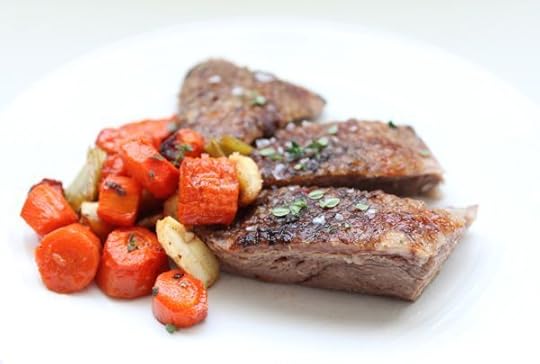
Grab The Primal Blueprint Cookbook Today and Receive Free S&H

November 16, 2012
I Will Never Go Back to the Broken Conventional Wisdom of My Past
It’s Friday, everyone! And that means another Primal Blueprint Real Life Story from a Mark’s Daily Apple reader. If you have your own success story and would like to share it with me and the Mark’s Daily Apple community please contact me here. I’ll continue to publish these each Friday as long as they keep coming in. Thank you for reading!
 Dear Mark,
Dear Mark,
I first heard about the Primal Blueprint from Slick Rick, the long haired, five fingered shoe wearing odd ball my cousin married. He had ditched grains four years before and never looked back, and was always dropping jokes about how he loved bacon. I thought he was crazy with his caveman talk and dismissed his low carb philosophy as one that didn’t fit into my modern diet.
You see, I took carb-a-holic to an extreme, consuming well past the 600 carb a day average of most Americans. I maintained a medium body size until I hit college, when I gradually began to pack on the pounds. By the time I was married at 28, I was overweight headed to obese, suffering from gastric reflux, fatigued, and unmotivated. The big blow came when my general practitioner diagnosed me with PCOS (Polycystic Ovarian Syndrome) after several unsuccessful months of trying to get pregnant with an irregular cycle. I assumed this was some genetic curse (after all, that’s what every doctor I talked to told me) and started down the path of Metformin and fertility drugs. I felt miserable, the meds made me crazy, and I got fatter on my SAD. After two years of failure, we took a break. I hated the way I looked and felt now 60+ pounds overweight and still without a baby. I joined a gym and hired a personal trainer determined to at least feel good about my body. Following six months of cardio four days a week, light weight training, and a restricted diet of healthy whole grains and low fat tasteless foods, I had a pathetic 15 pound weight loss, raging appetite, and shin splints to show for it. By this time my husband and I had decided to adopt, and brought home our little boy in October of 2009. I had a renewed “healthy” outlook and was determined to feed our growing family the best balanced nutrition I knew. We had the food pyramid down pat. Our diet was filled with whole grains, lean meats, and processed carbs and over the next two years I continued to gradually gain another 20 pounds.
As 2012 approached, and I began to think about New Year’s resolutions, my mom decided to motivate me and my sister-in-laws with a little weight loss challenge. She set up a Facebook group for us and a few friends to help encourage each other along the journey, told us to pick our diet of choice, and rewards were set for each month’s weight loss percentage winner. Almost everyone but myself went with Weight Watchers. I just couldn’t do the same old failing plan again. My mind began to drift back to Slick Rick. Could he be right? Maybe he wasn’t so odd after all. His diet seemed to go against everything that didn’t work for me in the past. My gut (no pun intended) told me I was eating too many carbohydrates, so I decided to give it a try and devoured The Primal Blueprint in just two days. I don’t like to do anything halfway so I fully committed to change and ditched grains, potatoes, and sugar, and ate lots of meat, vegetables, and fruit. I kept a Primal journal for the first few weeks to help me get started. Immediately the weight started to melt off just as I had read that it would. I began walking a moderate amount because of the new energy I gained, and slowly worked up to sprinting once a week and body weight exercises. Within a month, my gastric reflux was gone and I could eat all kinds of Primal foods that had given me indigestion in the past when paired with grains. I never felt deprived, and noticed heightened taste awareness of foods that wouldn’t have appealed to me previously. I lost my cravings for sugar and carbs and the desire to consume the foods that had been making me fat for years. I found foods that I enjoyed just as much or even better than those that had gotten me in trouble on the scales. I regained my love for bacon! I started intermittent fasting a couple times a week and was surprised at my lack of hunger pangs. At last! I was a fat burning beast!
After six months I had lost over 50 pounds, had a regular cycle for the first time in my life, and won every one of our group’s monthly challenges. (I really think my sis-in-laws were ready to kill me!) Everyone noticed the positive difference and many friends and family decided to adopt the Primal lifestyle as a result. I even converted a few of the ladies at the blood donation center as they watched my weight drop along with my cholesterol and blood pressure. My Type 1 diabetic husband was skeptical at first, but after several months he joined me along with our two year old son, and the benefits to our family grew. My husband lowered his A1C, took half the amount of insulin he had taken previously, and lowered his body fat from 18% to under 10%. We committed to buying locally sourced organic produce and grass fed meat, started our own backyard garden, and even became urban chicken farmers so that we could have the freshest eggs to support our growing habit!
I’m now at a 65 pound weight loss and I’m confident I will reach my goal of 80 pounds by the New Year. I’m more active than I’ve ever been and I know I’m becoming the healthy mom my son deserves. In June we became foster parents, and I love that this is one way we can have a positive influence on the health of the kids that share our home. This new lifestyle has truly changed my perspective and I will never go back to the broken conventional wisdom of my past. Slick Rick has now become one of my biggest supporters and frequently emails me the latest paleo videos, blogs, and recipes…and I promised him the Five Finger shoes if I win!
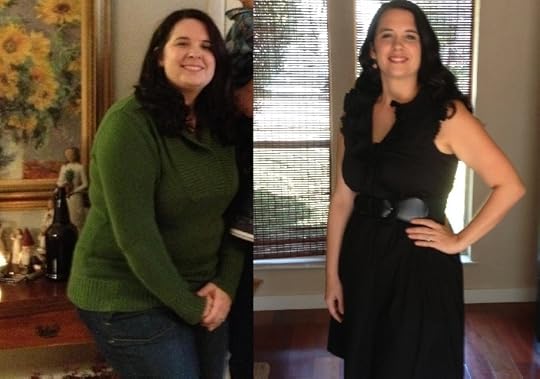
Thanks, Mark!
Angela
Grab The Primal Blueprint Cookbook Today and Receive Free S&H and a Free Primal Blueprint Poster

November 15, 2012
Do We Need Rites of Passage?
 The young native American teen sent off into the darkness with nothing but a bow and arrow and expected to return with a wolf pelt or two or three. The Masaai warrior tasked with stalking and killing a lion in single combat. The donning of a glove lined with stinging bullet ants to commemorate becoming a man. Ritualistic tattooing, branding, or mutilation upon reaching a certain age or completing a certain task. The bar mitzvah and bat mitzvah, celebrations of a Jewish boy’s and girl’s respective entrances into adulthood. The Latin American quinceañera. Rites of passage are nearly universal throughout human cultures, both ancient and modern. Universally-preserved behaviors, whether physiological traits, or cultural artifacts, are usually there for very good, or at least very important reasons. So let’s take a closer look. Why do we have rites of passage? Are they still a significant part of growing up in the modern world? If not, should they be?
The young native American teen sent off into the darkness with nothing but a bow and arrow and expected to return with a wolf pelt or two or three. The Masaai warrior tasked with stalking and killing a lion in single combat. The donning of a glove lined with stinging bullet ants to commemorate becoming a man. Ritualistic tattooing, branding, or mutilation upon reaching a certain age or completing a certain task. The bar mitzvah and bat mitzvah, celebrations of a Jewish boy’s and girl’s respective entrances into adulthood. The Latin American quinceañera. Rites of passage are nearly universal throughout human cultures, both ancient and modern. Universally-preserved behaviors, whether physiological traits, or cultural artifacts, are usually there for very good, or at least very important reasons. So let’s take a closer look. Why do we have rites of passage? Are they still a significant part of growing up in the modern world? If not, should they be?
Most anthropologists (PDF), citing Arnold van Gennep’s major work, “The Rites of Passage,” will say that rites of passage exist in order to consolidate social ties, establish roles, and give members of a group a sense of purpose and placement. They’ll say that the smaller the group, the easier it is to have cooperation and social cohesion. Consider a single family of hunter-gatherers – mom, dad, son, daughter. The four people in this situation aren’t like family; they are family. Cohesion is built-in, it’s natural. There’s no jockeying for position, no confusion over who does what and who listens to whom. The parents protect and provide for the youngsters, the youngsters listen to the parents. This is biological. No artifice required.
Meanwhile, the larger a group gets, the more it requires formalized roles, boundaries, and relationships to enable the same kind of cooperation and cohesion. To maintain social cohesion and maximize survivability, hunter-gatherer groups composed of not one but five, ten, or twenty families are going to have to figure out how to emulate the familial ties and bonds. It will contrive and create social connections and establish roles and statuses for the members. You can’t have everyone doing their own thing without a thought to the group, because survival will be that much more difficult. Resources are scarce – or, at least, there are no guarantees, no grocery stores – and working together improves their chance at thriving and surviving. People in the group need to feel like they belong to the group. Everyone needs a stake in a tribe, and rites of passage help provide that by establishing and formalizing the roles at various life-stages.
I certainly won’t argue with that analysis. It’s well established that humans are social animals, hominids that fight and argue and bicker and laugh and cry and, yes, work together. That’s just who we are, and it’s who we’ve always been (as long as we’ve been human, at least). We form groups, we band together, and we feel intrinsic bonds with our family members. We cohere and cooperate, and I agree that rites of passage and ritual make these social ties stronger and easier to establish. But I suspect there’s more to it.
Humans are self-reflecting, introspective, eager to ascribe deeper meaning to everything, and convinced that we’re the center of the universe. After all, all we know of the world is what we can perceive; our perceptions and our thoughts and our language effectively form our world. The world, in that respect, revolves around us, and our thoughts are more gonzo journalist than impartial observer, running commentary, giving a subjective slant to everything, and shaping our experiences as we go about our day. Is it any wonder that we’d ring in our passage into adulthood with burning brands, stinging ants, huge parties, and complex and solemn ritual, rather than go quietly into the next phase?
And of course, many rites of passage boil down to simple tests or indications of a person’s courage, fortitude, and/or aptitude. Going out by yourself and a spear and coming back with a lion’s pelt doesn’t just mean you’ve been ushered into the world of men. It also means that you are a capable hunter, a valuable addition to the group who can likely handle what the world will throw at you. Graduating college isn’t just a badge of honor; it (ideally) means you’ve garnered the skills necessary to flourish in your chosen field. Having your first menstruation isn’t just a symbolic shedding of your girlhood; it means you’re physiologically capable of getting pregnant. Rites of passage are also very utilitarian and practical, then.
Today, we have ID cards and social security numbers, badges and political party affiliations and Facebook friend lists, jobs and resumes and official titles to remind us and others who we are, where we are in the world, what we do, and who we know. Do these suffice? Or are we missing out on genuine rites of passage? Do we need the physical and mental ordeals? Do we need the formality?
Maybe. In many Western countries today, young people construct their own rites of passage, cobbling together experiences based on what they think becoming an adult actually entails. There seems to be some innate yearning for the rite of passage, some deep-seated sense that various “stages” of life exist, are real, and should be observed. “Am I a wo/man and no longer a child?” “When do I feel like a grown-up?” “What affirms this?”
I think we could all benefit from a rite of passage at one point or another to satisfy this yearning. But into today’s increasingly complex world there’s not going to be a “one size fits all” approach. We’re not living in small to large bands where you either take up hunting or fishing or medicine work, where what role you inhabit is limited by your immediate physical surroundings and the needs of your group. We have far more options and roles and jobs to fill, and we’ll have to find the rites that work for our unique situation. In that case, what would a modern rite of passage even look like?
Consider what Claire Potter did for her thirteen year old boy. She devised a list of thirteen challenges covering thirteen different areas of life for him to tackle and complete, including shopping for clothes on a budget, taking public transportation to far away cities, doing chores, learning a musical instrument and playing in public, and learning a language. He didn’t hunt lions or endure stinging ants, because he doesn’t “need” those skills. He’s more likely to use the skills he did learn in his life in this world.
This is just the tip of the iceberg on this topic, but I hope this gets a conversation going and gets you thinking about what role a rite of passage may or may not have played in your life.
What do you think, readers? Do we still need rites of passage? Do the old ones still apply, or do we need entirely new ones that make sense in today’s world? If so, what would they look like? Have you gone through a rite of passage? Tell us all about it in the comment section!
Grab The Primal Blueprint Cookbook Today and Receive Free S&H and a Free Primal Blueprint Poster

November 14, 2012
7 Ways You Might Be Inadvertently Sabotaging a Good Night’s Sleep
 Sleep is the cousin of death, wise men have said. Strange thought it may seem, though, avoiding this sometimes annoyingly-insistent-that-you-hang-out cousin will actually bring you closer to an early death. It’s not a pleasant thing to consider, but it’s the truth; bad sleep is associated strongly with early mortality, being overweight, having metabolic syndrome, and getting cancer. I’ve said it, your doctor says it, and anyone who’s ever had a bad night’s sleep and felt like death the next day will say it: sleep is absolutely essential to happiness, health, and longevity. On the positive side, there’s nothing quite so pleasurable as a good night’s sleep, from the initial application of one’s head to the pillow, to the insanely vivid dream-visions that descend upon you in the midst of it, to the peerless happiness and boundless energy you feel upon waking. Sleep’s the best, so you want to get it, and get it good.
Sleep is the cousin of death, wise men have said. Strange thought it may seem, though, avoiding this sometimes annoyingly-insistent-that-you-hang-out cousin will actually bring you closer to an early death. It’s not a pleasant thing to consider, but it’s the truth; bad sleep is associated strongly with early mortality, being overweight, having metabolic syndrome, and getting cancer. I’ve said it, your doctor says it, and anyone who’s ever had a bad night’s sleep and felt like death the next day will say it: sleep is absolutely essential to happiness, health, and longevity. On the positive side, there’s nothing quite so pleasurable as a good night’s sleep, from the initial application of one’s head to the pillow, to the insanely vivid dream-visions that descend upon you in the midst of it, to the peerless happiness and boundless energy you feel upon waking. Sleep’s the best, so you want to get it, and get it good.
You know it, of course. I harp on it enough. And chances are, you’re doing your part to get good sleep. But what if you can’t? What if sleep is bad, or inadequate, or unfulfilling? What might be causing it? Let’s find out.
You’re not getting any light during the day.
If you’ve read what I’ve written about blue light and sleep, you’re likely a champ with regards to blue light avoidance after dark. You’ve got the orange goggles. You’ve installed F.lux on all your computers (and you even jailbroke your iPhone to make it work there, too). You’ve set up black-out shades in your bedroom, and you’ve ditched the alarm clock with its blinking disruptive lights in favor of a personal rooster. And yet you still can’t get to sleep… what gives? Well, just as avoiding blue light after dark is important for normalizing your circadian rhythms and getting to sleep, exposing yourself to light during the day is also essential. Light’s entrainment capabilities go both ways. The whole problem with light at night is that it’s tricking your body into thinking it’s daytime. When it’s actually daytime, however, you need light. The whole daylong circadian cycle is important for sleep – not just the small snapshot taken right before bed. Try to get some sunlight on your eyes throughout the day, beginning (ideally) with the early morning. Right after you wake, go outside and take in the sun. Drink your coffee outside, or at least at a window facing the sun. At work, go outdoors for your breaks. Don’t say shut-in if you can help it.
You’re eating too late.
Remember the “early bird gets the worm”? The bird doesn’t have an actual alarm clock (trees don’t have power sources, duh!). By eating early in the morning, it has entrained its circadian rhythm to trigger early waking so as to obtain said food. This doesn’t just happen in birds, either. Rodent and primate studies show that feeding time is a powerful entrainer of the circadian rhythm, probably across species lines. In humans, the presence of C-peptide, which shows up after food intake and helps insulin do its job, strongly correlates with lower levels of melatonin. This suggests that eating depresses melatonin, the sleep hormone necessary for getting us ready to sleep. Couple that potential mechanism with the epidemiology of nocturnal eating being associated with negative effects on sleep quality, and you get a sneaking suspicion that eating late at night might be affecting some people’s ability to get a good night’s sleep.
You’re hewing to the popular advice to “stop eating carbs after 6 PM!”
Anytime I find myself thumbing through a Men’s Health or Shape or any other bad mainstream health and fitness magazine, I seem to stumble across this rule: no carbs after 6 PM. They’re usually imploring you to take this step in order to facilitate fat loss (which is false in and of itself), rather than to improve sleep quality. I’m all for the reduction in unnecessary carbohydrate from our diets, but if you’re going to eat carbs, sleep research indicates there’s absolutely no need to avoid them after dark or even right before bed. Heck, they can even be fast-digesting carbs, as one recent study showed that carbs with a higher glycemic index shortened sleep onset at night (people who ate the fastest-digesting carbs fell asleep faster than the people who ate the slow digesting carbs). So, if you’ve been avoiding all carbs after dark and eating them in the morning (to “provide energy”), you have probably been doing your sleep a disservice. If you’re gonna eat carbs, eat them at night. You should probably stop reading bad mainstream fitness magazines, too.
You’re exercising right before bed and failing to give yourself time to recover.
At night, your body reduces its temperature, and this drop in body temperature has been referred to as a physiological initiation of sleep onset and facilitator of entrance into the deeper phases. Since exercise raises body temperature, one wonders whether it could affect your sleep. In one study, researchers examined the effects of exercise on sleep with and without body cooling. Subjects ran for 40 minutes at 75% of their V02max on two occasions. The first time, the ambient temperature was raised, prompting a 2.3 degree C increase in subjects’ rectal temperatures. The second time, the ambient temperature was reduced, prompting just a 1 degree C increase in rectal temperatures. At rectal temperature +2.3, slow wave sleep (the deepest, most restorative portion of sleep) was increased. At rectal temperature +1, slow wave sleep was unaffected. This might sound like a big win for exercise-induced elevated body temperatures, but too much of a necessary thing isn’t always desirable. You want to maintain proper ratios between the various sleep cycles, and, as Dr. Emily Deans writes, spending too much time in slow wave sleep is typical of people with bipolar disorder and seasonal affective disorder, who often complain of lethargy, hunger, and weight gain. If you’re going to work out right before bed, give yourself time to cool off, perhaps with a cool shower, or move your workout to an earlier time.
You’re taking vitamin D too late in the day.
When you think about light and food and activity as entrainers of our circadian rhythms, that the timing of our supplementation with vitamin D might affect our sleep makes intuitive sense. Because what is vitamin D but an indication of daylight, of bright morning or afternoon sun emanating UV rays? If getting sunlight “tells” our body that it’s daytime, perhaps taking vitamin D sends a similar message. Although there’s no clinical trial showing this effect, Seth Roberts has been receiving accounts from readers who modified the quality and duration of their sleep by changing when they took vitamin D. Tara Grant, one of our biggest success stories and the first person to notify Seth, chronicled her experiences on her blog:
I looked aghast at the 10,000 units of Vitamin D I was taking. It was 7 o’clock at night! I was essentially giving my body 15 minutes worth of bright sunlight energy. No wonder I was waking up in the middle of the night! I was telling my body that it wasn’t really time for bed, it was still the middle of the day.
I’m not surprised, and I wouldn’t be surprised if this worked for the diligent, dutiful Primal eater who’s been doing everything right but who gets bad sleep. And hey, say you try it and it doesn’t work, it doesn’t have any effect whatsoever on your sleep? No harm done. It’s worth a shot.
You don’t have a nighttime ritual.
I’ve spoken before about the importance of ritual in our lives and our development as a species. What about the importance of ritual in sleep? Any parents out there know how crucial it is to establish a nighttime routine with children so that both child and parent get better and more regular sleep, and I’d argue that all humans – especially modern ones – could use some sort of nighttime ritual to wind the night down and get ready for sleep. It might feel a bit odd at first, because you’re consciously directing your focus toward something that normally comes natural. But today’s world is different. It’s got different stressors – and more of them. It’s got more stimulation – from lights, from sounds, from advertising, from the Internet. We need to force ourselves to unwind. So, about an hour to two hours before your desired bedtime, start winding down. “Winding down” will look different for everyone, since what winds me down won’t necessarily wind you down. What’s important is that you feel rested, relaxed, and calm. I like chatting with my wife about our days in bed with a good book at my side amidst dim, soft light; that seems to wind me down and get me ready to sleep. You might find a fifteen minute session of stretching does the trick for you, or cleaning the kitchen, or taking a warm shower, or praying to your deity of choice. Whatever it is, find it, and do it on a regular basis so that your body begins to associate it with the onset of sleep.
You’re still staying up too late.
I don’t care how orange your goggles are at night. I don’t care if you’re staying up late to read about health and fitness and evolutionary nutrition. You’re still staying up way too late. If you’re fighting yawns and relaying to your Skype chat buddies just how exhausted you are, why the heck aren’t you sleeping? Your body can try to get you to go to sleep all it wants, it can secrete enough melatonin to fill a shot glass, but if you consciously make the decision to stay up and do whatever it is that’s somehow so important, you’re not going to sleep and you will suffer for your lack of it. Your conscious self is the ultimate arbiter of your day to day decisions. Hormones and neurotransmitters and the like have their say and can nudge you in various directions, but you have to decide to close the laptop, turn off the light, shut down the television, and lay your head down to sleep.
That’s it for today, folks. I hope these tips hit home! Sleep is a tricky one to tackle, mostly because it seems like the realities of modern life run counter to our need and desire for it, but it doesn’t have to be (and, if we care about our health, we have to figure it out!). Feel free to leave anything you’ve learned along the way in the comment section!
Grab a Copy of The Primal Blueprint 21-Day Total Body Transformation and Start Getting Primal Today!

November 13, 2012
Is It Primal? – Non-Alcoholic Beer, Non-Alcoholic Wine, Gluten-Free Beer, and Other Foods Scrutinized
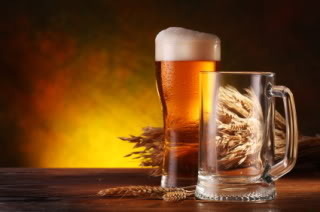 I suppose you could call today’s “Is it Primal?” the alcohol edition, because we’re dealing with three alcohol-related inquiries. Actually, two of the inquiries relate to non-alcoholic beverages, one to an alcoholic beverage, one to a substance that can potentially facilitate alcohol-induced activities, and one to a substance that can help relieve sunburns that you get after passing out in the sun from too many alcoholic beverages. Okay, that’s a bit of a stretch, but I think you get the point. I dig into the suitability and Primality of non-alcoholic beer, non-alcoholic wine (the horror!), gluten-free beer, the Andean aphrodisiac known as maca root, and the humble but ubiquitous aloe vera.
I suppose you could call today’s “Is it Primal?” the alcohol edition, because we’re dealing with three alcohol-related inquiries. Actually, two of the inquiries relate to non-alcoholic beverages, one to an alcoholic beverage, one to a substance that can potentially facilitate alcohol-induced activities, and one to a substance that can help relieve sunburns that you get after passing out in the sun from too many alcoholic beverages. Okay, that’s a bit of a stretch, but I think you get the point. I dig into the suitability and Primality of non-alcoholic beer, non-alcoholic wine (the horror!), gluten-free beer, the Andean aphrodisiac known as maca root, and the humble but ubiquitous aloe vera.
Let’s get to it, shall we?
Non-Alcoholic Beer
Although I think alcoholic beverages can be a sensible vice for PBers (I’m partial to wine), alcohol is undoubtedly a poison. Most people can handle a bit of this particular poison without doing any real damage – particularly if they take some steps to support their detoxification systems and choose alcohol with beneficial secondary compounds – but not everyone responds well to or wants to consume alcohol. If you’re in that boat but still want to enjoy a drink, you generally have but one option: nonalcoholic beer.
Before you laugh, know that nonalcoholic beer is actually alcoholic beer up until the last couple steps where the booze part is removed. Removal is done either via vacuum distillation, which changes the pressure to allow boiling at a lower and less disruptive temperature, or reverse osmosis, which doesn’t require any heating at all. Sure, nonalcoholic beers generally won’t taste as good as your favorite brews, but that’s mostly because the better breweries aren’t really bothering to make nonalcoholic beer. If your favorite craft brewery did decide to remove the ethanol from your favorite brew while leaving everything else the same, it would probably be almost as good. There’s just not a large enough market to drive the brewing of high-quality craft non-alcoholic beer. At least, not yet.
For the most part, I don’t see anything wrong with enjoying a non-alcoholic beer. I still have a beer from time to time, just because I enjoy it that much, and if you’re not overly sensitive to the gluten in most beers, you’ll probably be okay. Plus, non-alcoholic beer has some health benefits.
Beer improves copper utilization in rats with copper deficiency, thereby preventing the negative effects (which include atherosclerosis). This effect does not depend on the alcohol content.
Non-alcoholic beer aids marathon recovery. I could have sworn regular beer used to help back in my running days, but maybe I was wrong. Maybe if I stuck to O’Douls, I could still be out there today!
Non-alcoholic beer helps shift-working nurses get better sleep and enjoy reductions in anxiety. This effect was attributed to the hop content of the beer.
The silicon content of beer – not the alcohol – may reduce the risk of osteoporosis. Non-alcoholic beer should therefore have this effect.
The only thing that might keep you away is the gluten content. The market for good gluten-free beers is somewhat limited, and the market for good nonalcoholic gluten-free beers is even more limited. Luckily, the brewing process generally removes most of the gluten from beer, and, at any rate, the gluten content of beer pales in comparison to the gluten content of something like bread. One test of fifty beers found that 35 of them contained between 1 and 200 ppm of gluten, and 15 had less than 1 ppm. As a comparison, wheat bread has roughly 75,000 ppm of gluten. According to the World Health Organization, food with less than 20 ppm can be labeled “gluten-free,” though your mileage may vary.
Verdict: Not Primal, but perhaps worth a cheat if you’re not sensitive to gluten.
Non-Alcoholic Wine
Just like non-alcoholic beer retains the health benefits of its alcoholic counterpart, non-alcoholic wine retains many of the benefits associated with real wine. Unfortunately, non-alcoholic wine just doesn’t seem to taste very good. Actually, scratch that: it tastes just fine, just not like real wine. You see, more so than with beer, the alcohol content of a good bottle of wine ties the flavors all together. It provides the body, the mouth feel, the “thickness.” Without the alcohol, wine ends up tasting thin, rather than big and thick. Experts say the best non-alcoholic wines are the sweeter, bubblier ones, the ones that attempt to ape champagne and riesling and the like, rather than the bigger reds.
Taste and mouth feel aside, non-alcoholic wine will contain all the same polyphenols as alcoholic wine made from the same grapes, under the same conditions, given the same amount of time to develop, and aged in the same barrels. I’ve spoken about the anti-oxidative benefits of using wine as a marinade or cooking sauce (it reduces lipid oxidation and the formation of carcinogenic compounds during cooking), which is dependent on the polyphenols – not the alcohol; non-alcoholic red wine retains all the polyphenols and should have the same effect. And one recent study found that non-alcoholic red wine lowered blood pressure in human subjects, while alcoholic red wine did not.
Verdict: Primal.
Gluten-Free Beer
If you are celiac, gluten-sensitive, or just react poorly to gluten-containing foods, you’re probably going to want to reach for a gluten-free beer. As stated above, a gluten-free beer will have a gluten content lower than 20 ppm. If that doesn’t mean anything to you, and you want to have something to compare it to, let’s look at the gluten content of another common food.
Naturally fermented soy sauces that contain wheat register under 20 ppm. That said, you generally don’t drink 12 ounce bottles of soy sauce (or do you?). By sheer volume, you’ll be ingesting more gluten, but far less than comes from even that tiny crust of bread you love to sneak at the restaurant. Unless you’re confirmed that you react to miniscule amounts (around 1 ppm) of gluten, gluten-free beer will probably be fine.
Regarding the silicon effect mentioned in the non-alcoholic portion of this post: although barley is the most common source of silicon in regular beer, hops are also rich in silicon. If you want a silicon-rich gluten-free beer, look for hoppy ales – pale ales, India pale ales, etc. Sorghum also tends to absorb silicon from the soil, so any sorghum-based gluten-free beers should contain sufficient amounts of silicon.
Most of the polyphenols in beer come from the hops, rather than the barley, so gluten-free beers that contain hops (a gluten-free component) should have the same antioxidant activity as regular beers.
Verdict: Not Primal, but a better alternative than regular beer and a nice option for an 80/20 situation.
Aloe Vera
Anyone who’s ever had a real bad sunburn has probably crossed paths with aloe vera gel, but did you know that aloe vera the plant enjoys a storied history as a healing herb? As far back as 2,000 years ago, physicians, healers, and medicine men have been prescribing aloe for a number of ailments. It’s been used to improve digestion, reduce constipation, and facilitate purgation. In enema form, it apparently “removed worms from the rectum” of the afflicted. In men, it was said to increase erections and sexual appetite. Women between puberty and menopause could supposedly rely on aloe to “relieve the nervous manifestations which often accompany that interesting period in woman’s life” and increase their menstrual flow. And aloe was also said to give “tone to muscle tissue” and exert “a special influence on the liver.” Sounds pretty magical, right?
But does it really do anything?
Its topical effect on burn wounds is well-known, with a recent meta-analysis concluding that aloe vera-containing products reduce burn healing time by 8.79 days on average. Since the products often contained other ingredients and weren’t standardized for aloe vera content, all that can be said is that “some amount” of aloe vera is effective against burns.
Oral aloe vera has anti-hyperlipidemic and anti-hyperglycemic effects. A recent study found that in type 2 diabetes patients with bad blood lipids and excessive fasting blood sugar levels, a 300 mg capsule of aloe vera gel taken every twelve hours for two months lowered LDL, HbA1c, fasting blood glucose, and total cholesterol. No adverse effects were reported, and liver and kidney function tests checked out.
An extract of aloe vera even shows promise as a promoter of dental pulp cell proliferation (the stem cells that “turn into” teeth) and the mineralization and formation of dentin. The study involved capping the exposed upper molars of rats in either the aloe extract (acemannan) or a control for 28 days, so it’s not as simple as swishing with aloe vera juice every night.
Aloe is certainly good as a laxative, but there’s no concrete evidence that I’m aware of for its use in healing damaged stomach tissue. You could give it a shot in an experiment of one, of course. Just note that chronic oral aloe vera consumption has been linked to hepatic toxicity in some cases. Doses of between 250 and 500 mg per day were cited – a not unheard of amount, so use caution.
Verdict: Primal, but be sure to use medicinally, not chronically.
Maca
If aloe’s supposed aphrodisiac effects are based in obscure folk wisdom, maca has actual clinical trials. Maca appears to be that rare substance that actually works as advertised. Most importantly, it increases sexual desire, function, and fertility in both men and women.
In men with mild erectile dysfunction, maca root increased subjective perceptions of general and sexual well-being, beating out the placebo group.
In men and women suffering from SSRI-induced sexual dysfunction (disinterest, low libido, inability to attain arousal), patients taking maca root experienced significant improvements. Libido increased and arousal became possible on both 1.5 grams per day and 3 grams per day, though the larger dose was more effective.
In post menopausal women suffering from sexual dysfunction, 3.5 grams a day of powdered maca reduced anxiety, depression, and sexual dysfunction when compared to a placebo. Interestingly, these effects were independent of any changes in hormonal profiles (neither androgenic nor estrogenic).
In men aged 21-56, both 1.5 and 3 grams per day of maca root increased sexual desire, with the larger dose having the greater effect. As with the previous study on postmenopausal women, the increase in libido was independent of any changes to male hormonal profiles.
Maca also increases sperm count, sperm motility, and ejaculate volume without affecting serum hormone levels in men.
Maca also has some neuroprotective effects, at least in rodents, but the sex angle is the most studied.
If you decide to try it, don’t necessarily rush out and buy the raw maca. Traditionally, maca root was eaten as a root vegetable in Peru – cooked, boiled, mashed, or turned into flour. It wasn’t eaten raw to “preserve enzymes” or some other such thing. Raw maca is generally less expensive than gelatinized maca, but the latter is more concentrated with the starch removed, and perhaps more effective. Furthermore, since maca is in the brassica family (along with cabbage, broccoli, and kale), it has goitrogenic qualities that increase the requirement for iodine. Raw maca is going to have more goitrogenic activity than heat-treated maca.
If I were going to use maca, I’d be interested to see if it boosted sexual desire. That’s where most of the best research has been done. I’d do about 1.5 to 3 grams daily, which seems to be the effective dose range. I’d make sure to eat extra iodine-rich foods, like seafood and sea vegetables. And I’d treat it like a medicine, taking it when and if I felt I needed it and removing it if any untoward effects were felt.
Verdict: Primal.
That’s it for today, folks. I hope I’ve given you some new things to try, or to avoid, and that you find my advice helpful.
Grab The Primal Blueprint Cookbook Today and Receive Free S&H and a Free Primal Blueprint Poster

November 12, 2012
Dear Mark: Vegetable Juicing, G_BOMBS, Blood Sugar, and Hot Workouts
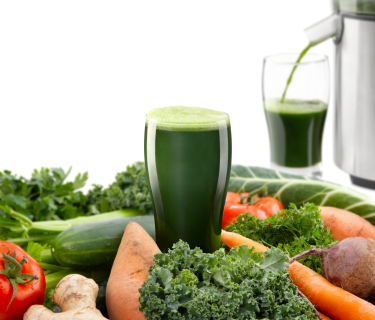 Today is going to be a bit of a long Dear Mark blog post. I got some great questions from you guys. First, I cover three questions regarding the insulin spike and carb load from vegetable juicing. Next, I discuss the place of G_BOMBS, or the “perfect nutritional combination” of greens, beans, onions, mushrooms, berries, and seeds, in a Primal eating plan. The blood sugar response to meat is next, along with a followup question about how dietary fat affects the glycemic response to eating carbohydrates. Finally, I field a question regarding the utility of artificially increasing one’s propensity to sweat during workouts by turning the air conditioner off. Does it hurt? Does it help? Find out below.
Today is going to be a bit of a long Dear Mark blog post. I got some great questions from you guys. First, I cover three questions regarding the insulin spike and carb load from vegetable juicing. Next, I discuss the place of G_BOMBS, or the “perfect nutritional combination” of greens, beans, onions, mushrooms, berries, and seeds, in a Primal eating plan. The blood sugar response to meat is next, along with a followup question about how dietary fat affects the glycemic response to eating carbohydrates. Finally, I field a question regarding the utility of artificially increasing one’s propensity to sweat during workouts by turning the air conditioner off. Does it hurt? Does it help? Find out below.
Dear Mark,
I’m a big fan of the Primal Blueprint diet and lifestyle but I have a few questions for you about vegetables.
Lately, I’ve fallen in love with the nutritional content of vegetables. I try to eat them at every meal but in an effort to maximize my veggie intake, I recently bought a juicer and am experimenting with having fresh vegetable juice for breakfast. (And then I eat whole veggies at lunch and dinner, with protein and fat, of course.) So I wanted to ask you:
1. Does fresh vegetable juice cause a huge insulin spike in one’s bloodstream?
2. Would this spike be higher than if you ate the vegetables themselves (because you’re not eating the fiber at the same time)?
3. Would the number of carbs in the juice of one beet or the juice of one cucumber be the same as eating one whole beet or one whole cucumber?
I would still like to lose about 15 pounds of fat, so if you think my extra intake of veggies is going to cause my carb intake to skyrocket then I will think twice about continuing with the juicing.
Thank you for all your great work and thank you in advance for your advice!
Kind regards,
Jean
I’ll just run down the questions in order.
1. It totally depends on the vegetable you’re juicing. The main reason, after all, that I suggest you limit fruit juice is that it’s a huge bolus of sugar without the fiber and the satiation that comes from eating whole fruit. You can eat an apple and you’ll be pretty satisfied, but a glass of apple juice goes down like water, doesn’t really fill you up, and contains the sugar of four apples. That’s four times the sugar (and nearly four times the calories) with a fraction of the satisfaction. Sitting down to breakfast with a tall glass of apple juice, then, is like adding a bag full of apples to your breakfast.
Most vegetables don’t have that problem. Yeah, if you were drinking nothing but carrot and beet juice, you’d be getting a fair amount of sugar, but even a four ounce portion of carrot or beet only has about ten grams of sugar. And all the other vegetables you’re probably juicing, like lettuce, kale, chard, spinach, cucumbers, broccoli, are so low in calories and carbs that they’re not worth fretting over. Honestly, I wouldn’t worry too much about the carbs in vegetable juice.
2. Yes, the (insignificant) spike will be higher after consuming juice than after consuming the whole vegetable. In studies with whole fruit and fruit juice (very few, if any, studies are out there comparing vegetable juice to whole vegetables, so we’ll have to use the fruit juice research), whole fruit tends to elicit a lower insulin spike than fruit juice, an effect authors attribute primarily to the fiber. In fact, fiber has even been used in diabetics to help maintain their glucose control. That said, vegetable juice doesn’t have much sugar with which to spike your insulin. Again, I wouldn’t worry too much about it.
3. The number of carbs will be the same minus the fiber from the whole vegetable. If a beet has around 2 grams of fiber, that amount will be subtracted from the juice.
Although juicing vegetables won’t really affect your insulin levels one way or the other, I would caution that by discarding the fiber, you’ll be missing out on some polyphenols. Fruit and vegetable fiber isn’t “just fiber”; it also contains bioactive phytochemicals that may be of some use to you. Also, the effects of some polyphenols seem to be compounded when eaten with plant fiber, as is the case with apple pectin (a soluble fiber) and apple polyphenols. Overall, the fiber increases the bioavailability of plant antioxidants. Whole foods win again! Luckily, you state that you’re eating plenty of whole vegetables in addition to the juice, so I wouldn’t be too concerned. If you weren’t eaten the whole vegetables, I’d probably urge you to consider smoothies over juice, since smoothies retain the fiber.
I am hearing a lot about the G_BOMBS greens – beans – onions – mushrooms – berries – seeds as the perfect food combination. How does it fit into a Primal lifestyle?
D Brown
You’re asking whether greens – broccoli, chard, spinach, lettuce, kale, Brussels sprouts, dandelion greens, collard greens, mustard greens – are suitable for Primal eating? I eat some of those every single day.
You’re wondering if onions are okay on this plan? Yes, onions are great.
Shiitakes, buttons, whites, criminis, portabellas, boletes, chanterelles, morels, and select aminitas? Absolutely; mushrooms are the best.
Blackberries, blueberries, gooseberries, raspberries, loganberries, lingonberries, strawberries, boysenberries? Nothing like a fresh bowl of berries. Have at them.
How about seeds? Can you be Primal and still enjoy pumpkin, sunflower, squash, chia, hemp, and sesame seeds? Yes.
Yes, those are all excellent food sources for anyone. There’s this somewhat popular blog that’s even written a few articles on some of those foods:
Why You Should Eat Leafy Greens
Why You Should Eat Sulfur-Rich Vegetables (onions)
Smart Fuel: Shiitake Mushrooms
Why You Should Eat Brightly Colored Fruits and Vegetables (including berries of all kinds)
A Quick Guide to Edible Seeds
Luckily for those on a Primal eating plan (and those people who share the bed with them), omission of the beans part of the G_BOMBS is both possible and advisable. Since you’re getting most of your protein from complete animal sources, you won’t be needing to rely on a stomach-disrupting, nigh-indigestible legume for the six or seven or however many grams of protein it offers. If you were on a vegan diet, you’d probably need to throw in some beans for protein. You’re not though. I therefore dub this new eating plan the GOAMBS diet: greens, onions, animals, mushrooms, berries, and seeds. And by “new,” I mean several million years old, of course.
Dear Mark,
Have you heard of the 80/10/10 (80% carbs/10% fat/10% protein) diet? Specifically it mentions eating a beef burger raising blood sugar levels. And also claims without fat in the stomach that fruit, pasta, etc. raising of the blood sugar level is quicker and not a problem. Can you please address these (faulty) points? Love your blog and thanks for changing my diet and my life for the better!
Grok on!
Thanks
Josh
Eating anything will raise blood sugar levels. That’s a normal physiological response to the introduction of food to your body. And sure, a “beef burger” will raise blood sugar levels, particularly if it comes with a bun, french fries, and large drink, but what are we really talking about here? Is it the “burger” part that’s causing a blood sugar spike, or is it the “beef” part?
I’d say it’s the former. White bread – of which hamburger buns are made – has one of the highest glycemic responses around. It averages around a 75 on the glycemic index. As for beef, it doesn’t even register on the glycemic index. There are no carbohydrates in ground beef; there’s nothing there to prompt a significant blood glucose response. It’s what you eat the beef with that causes the glycemic response. Interestingly, a beef burger, which has fat, protein, and carbs, will raise blood sugar to a lesser degree than a bun by itself. So, yes, a beef burger will “raise blood sugar levels,” but so what? Just about everything does. What matters is the magnitude of the increase. Lower is generally better.
And yeah, it’s true that eating a carbohydrate (like fruit or pasta) without fat will make for a quicker blood sugar increase, but as for it being “not a problem”? I beg to differ. It will make for a quicker and larger increase, whereas eating your carbohydrates with a fat (in the context of an actual meal with several different foods) will result in slower gastric emptying and a lower spike in blood glucose. Lower spikes – even if they’re more sustained – are less problematic. Higher spikes – even if they’re less sustained – are worse.
Postprandial hyperglycemia, a causative factor in vascular (and other health) complications, is defined as blood sugar greater than 140 mg/dl. As Paul Jaminet points out, eating carbs as part of a whole meal (with fat and protein and other nutrients) reduces the blood sugar response and prevents hyperglycemia. By all accounts, this is preferable.
Dear Mark,
I have recently moved to a very hot climate and our power generator (and thus air conditioning) only comes on at six. I have a friend who advocates working out without the a/c on because, in his words, “if you sweat more you get a better workout”. Is this true? It sounds like nonsense.
Best,
Duncan
I see where he’s coming from, kinda. Harder workouts will generally cause you to sweat more, and harder workouts are “better” in some cases. The really intense ones are definitely more productive and effective, so it may feel like encouraging the sweat however you can is going the make the workout better. But it’s not the sweat that’s making your workout effective; it’s the work you’re performing. It’s how fast and how far you’re going, how much weight you’re lifting, how many reps you’re completing. The sweat is just an indicator, a byproduct of the true actor. And it’s not even a very reliable indicator. Sweat doesn’t always mean “effort” or “intensity.” You’ll sweat through a suit jacket just from walking outside in the tropics. Sweat simply means that your body is trying to cool off and reduce its temperature.
Since increasing the ambient temperature tends to increase sweating, we might use temperature increase as a surrogate for increased sweating. In fact there are a number of studies examining the effect of ambient temperature on exercise performance and fuel partitioning. Let’s look:
Increasing the ambient temperature during exercise increases serum lactic acid and reduces serum free fatty acids in trainees. Since lactic acid is a byproduct of glycogen metabolism and free fatty acids indicate the mobilization of body fat for energy, working out in hotter conditions may “burn less fat” than working out in cooler conditions. I doubt it makes a huge difference, but it might prove a helpful nugget of info for your friend.
Increasing ambient temperature may actually reduce voluntary workout intensity. In a recent study, cyclists were told to maintain a “constant rating of perceiving exertion” while scientists covertly increased and then decreased the ambient temperature in the room to see how power output changed. Although ambient temperature had a definite effect on voluntary power output, the behavioral alterations did not respond directly to the temperature fluctuations. A hot room probably makes you workout “less hard,” but it’s not a linear relationship.
All that said, it’s not the sweating that affects the exercise. If you really want to increase the effectiveness of your workout, increase the intensity. Don’t try to cheat by raising the temperature or wearing a thick black sweatsuit in the hot sun. You might cut water weight, but you won’t lose any more fat (and you might actually burn less of it) and you might reduce intensity without even knowing it. There might be a therapeutic placebo type effect going on with a hard sweat. Your friend might feel more satisfied or accomplished after a workout in which he sweated through the carpet, so in that sense he’d be having a “better” workout without the AC. If you enjoy your workout more or feel like you got more out of it because you produced a ton of sweat, I’d say you keep on doing it. The mental state is important.
That’s it for today, guys. Keep sending questions and I’ll keep answering them. Take care and Grok on!
Get the Primal Blueprint Fitness eBook, Free Health Tips and Primal Recipes Delivered to Your Inbox

Mark Sisson's Blog
- Mark Sisson's profile
- 199 followers



